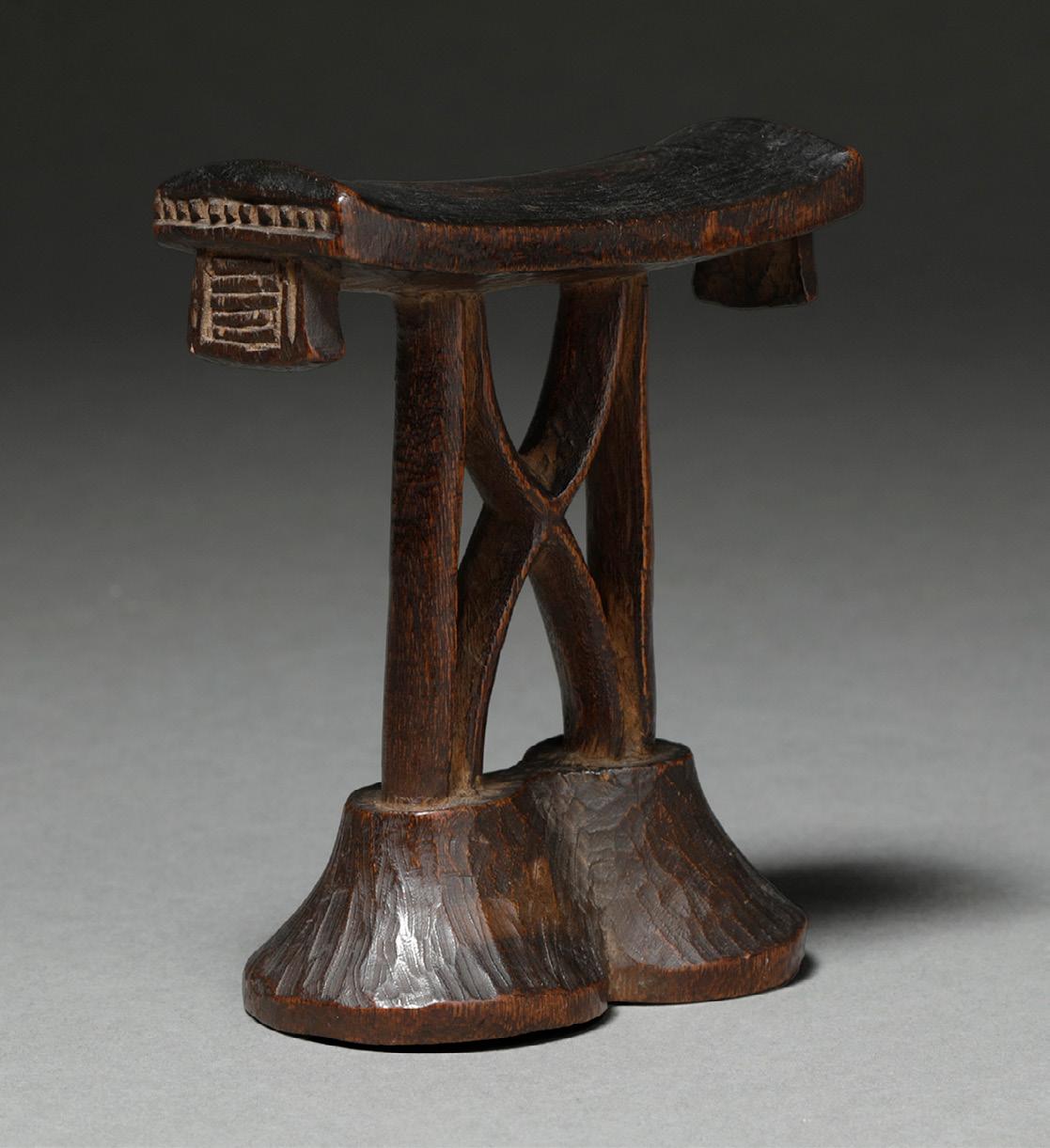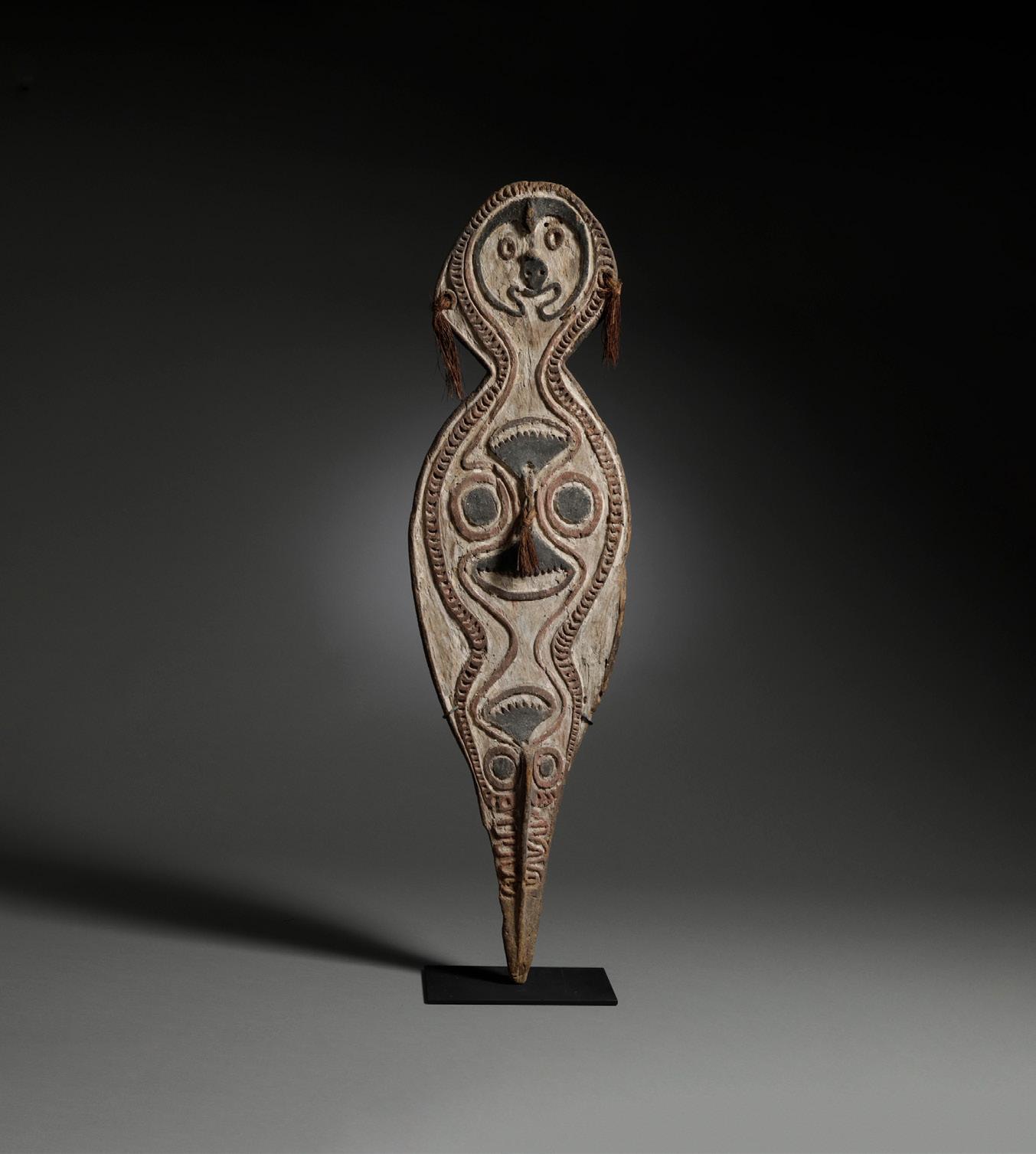

THE SCHOLAR’S EYE
SELECTIONS FROM THE ROY AND SOPHIE SIEBER COLLECTION
THE SCHOLAR’S EYE
SELECTIONS FROM THE ROY AND SOPHIE SIEBER COLLECTION
‘Any serious collecting … must come down to an aesthetic decision, which is what constitutes connoisseurship.’ roy sieber
It is our great pleasure and honor to present a selection of exceptional artworks from the distinguished collection of Roy and Sophie Sieber.
These works represent not only a deep personal connection to the art, but also the pioneering efforts of Roy Sieber, who is widely recognized as the founder of African art history as a formal academic discipline in the United States. His groundbreaking scholarship and dedication to the field have had an enduring influence on the study and appreciation of African art worldwide.
This collection, amassed over decades, is a testament to the Siebers’ passion for preserving and celebrating the rich artistic traditions of Africa and beyond. Many of the objects being offered are coming to the market for the very first time, providing a rare opportunity for collectors, scholars and enthusiasts to engage with these works of art. Each
piece in the collection reflects the Siebers’ discerning eye and their commitment to understanding and sharing the cultural significance of the artworks.
We would like to express our gratitude to Ellen Sieber, Matt Sieber, Mark Sieber and Thyne Rutrough, for entrusting us with the privilege of working with their parents’ collection. Their support has made this presentation possible, and we are deeply appreciative of their collaboration in bringing these remarkable pieces to a wider audience.
We invite you to explore the richness of this collection and reflect on the legacy of Roy and Sophie Sieber, whose contributions to the field continue to inspire and resonate today.
Dori & Daniel Rootenberg new york city, january 2025

ROY AND SOPHIE SIEBER
ALEX COPELAND
Roy Sieber (1923–2001) was a man possessed – not only of profound insight and humanity, but a passionate hunger for meaning that awakened the authentic understanding of non-Western traditional art in the United States. Sieber’s contributions to the study and curation of tribal art have been incalculable. His methods and motives, born of a curiosity unsatisfied by the limited scholarship of the early twentieth century, fostered an entire generation of researchers, experts and curators. From the deep well of Sieber’s wisdom sprang the appreciation of tribal art in the West as we know it.
Of invaluable support to Sieber’s landmark efforts was the energy and dedication of his wife, Sophie, who was truly Roy’s partner in work as well as in life. Over decades she meticulously deciphered and transcribed to the typewritten page every book, article, and letter that Roy, who had never learned to type, originally drafted by hand. This body of writing was, to put it mildly, voluminous, and without Sophie’s intense interest and organization it would never have seen its full emergence and success.
Born in 1923 in Shawano, Wisconsin, Roy Sieber showed an avid interest in art and literature from early childhood. During family trips to Chicago, he made regular visits to
Roy Sieber, Iowa City, 1956
the Art Institute and especially the Field Museum, where the anthropological collections held a particular fascination for him. He carried that inspiration with him through his teenage years, and in 1941 enrolled at the State Teacher’s College in Milwaukee, where he studied studio arts and art history. A period of military service followed, after which he studied medicine and art through most of the 1940s, largely in New York City, where he lived in close contact with a multitude of museums and galleries that fed his ever-growing curiosity. During a brief stint in 1948 as a camp counselor, he met fellow counselor Sophie, who would become his wife two years later. In 1949, he enrolled at the State University of Iowa, where art history at last became his primary focus.
Sieber’s interest in the arts of Africa, Oceania, and the Americas came alive during this time when he took his first class on ‘primitive’ art. Finding the course wanting in every possible area, he challenged himself to learn more, attending additional classes and beginning to do serious reading on his own. When the previous professor left, Sieber, by now immersed in the available literature, taught a course on nonWestern art himself. Disallowed by the university from basing his dissertation on African art, he continued to pursue his interest in the subject, making contact with anthropologist Melville Herskovits. In 1956, with the help of Herskovits,

William Fagg and Raymond Wielgus, Sieber created his first exhibition, African Sculpture, for the University’s Festival of Fine Arts. His zeal and determination eventually convinced the administration to approve his dissertation, and in 1957 Sieber became the first scholar in the United States to receive a Ph.D. in African art history.
This milestone achieved, Sieber expanded the scope of his work with the aid of a Ford grant, traveling first to London and then to Nigeria, an experience he described as ‘an exercise in discovering Africa.’ While living in Jos, a city in the North-Central region of the Federal Republic of Nigeria, an lgala steward opened up to him the arts of the Igala and the Idoma, and the basic framework for much of Sieber’s scholarship was shaped, emphasizing field work and thorough investigation of specific time periods and littleknown forms. In a field in which wooden masks and figures were nearly the only objects of serious discussion, Sieber envisioned a much broader definition of African art.
Two exhibitions followed – Sculpture of Northern Nigeria and Nigerian Arts – and Sieber took on his first graduate student, Arnold Rubin. In 1962, after helping to build the University of Iowa’s collection of African art, Sieber accepted an invitation to Indiana University as one of a select group of scholars who would form a dedicated African Studies Program there, exploring the many facets of African history and culture in dialogue and concert with one another. His tenure at the University would go on to last more than three decades. In his early years at IU, he made several trips to Africa and taught as a Visiting Professor at the Institute of African Studies at the University of Ghana and also at the University of Ife, helping to establish the former’s museum.
Sieber’s influence on the perception of non-Western art continued to grow through a succession of groundbreaking exhibitions and the catalogs that accompanied them. Sculpture of Black Africa (1968), which featured the Paul Tishman Collection, was co-written by Sieber and Arnold
Roy Sieber 1958 Nigeria

Rubin for an exhibition at the Los Angeles County Museum of Art. Here the two scholars used an entirely different organizational approach than that established in the 1930s by Carl Kjersmeier, which had neglected historical relationships and grouped artworks based on geographical distribution. Sieber and Rubin’s methodology was based on style zones –characterized by complex historical, linguistic, and stylistic factors – that were further categorized based on works attributed to certain ethnic groups. This framework has since been used and developed by generations of African art historians and remains a standard basis utilized in most modern textbooks on the subject. It is important to note that, in its early years, the study of African art lacked any comprehensive textbooks, and researchers and educators relied on journal articles and exhibition catalogs to provide the overviews, case studies, and detailed analyses they
required. Sieber was a major contributor to many of these resources.
A powerful element of Sieber’s approach had begun to emerge during this period, which was his spirit of true collaboration. Over the course of his career and through his close connections with both colleagues and students, he engendered a methodology that valued a multiplicity of perspectives, championing shared goals and the strength of united effort. His generous and open engagement drew admiration from his peers, opening the way for a richer and more nuanced milieu.
Two more exhibitions in this era that showcased Sieber’s inclusive approach were produced in collaboration with collector Katherine White. These traveling shows, which included objects from White’s collection, expanded the very definition of African art by inviting crafts and utilitarian
Mark and Thyne Sieber 1958, Jos Nigeria
objects into the company of figures and masks. For African Textiles and Decorative Arts (1972), White assembled from dozens of public institutions and private collections a tremendous cache of images from which she and Sieber spent hours making selections. This trove of material also provided for the early development of African Furniture and Household Objects (1980), which the pair co-curated. Happily they were met with great popular success, opening the eyes and minds of a much broader audience to the beauty and scope of works from the African continent. Their associated publications remain classics in the field.
In 1983, Sieber joined the staff at the Smithsonian Institution’s National Museum of African Art, where he would serve for the next ten years as Associate Director for Collections and Research, evaluating research of the Museum’s collections and developing standards for acquisitions. Alongside Rosyln Adele Walker, he served as co-curator and co-author of the exhibition and catalog African Art in the Cycle of Life (1987–88), the inaugural exhibition of the Museum’s present site on the National Mall in Washington, DC.
Sieber retired from both the Smithsonian and Indiana University in 1994, concluding an academic career of remarkable importance in the study of non-Western art. Near the end of his life, he was awarded a Distinguished Africanist Award by the African Studies Association for his lifetime of achievements. John H. Hanson, director of the African Studies Program at Indiana University, considered Sieber’s contributions to African art and the humanities unparalleled, saying, ‘whether as a museum professional, channeling scholarly concerns through the medium of African art exhibitions, or as an IU professor lovingly guiding countless students through the learning process, Roy Sieber shaped much of what is today known and understood about African art in all its forms.’
The depth of Sieber’s legacy can be partly measured in the art history professionals who have followed in his
footsteps. During his tenure at Indiana University, he taught hundreds of undergraduates and mentored dozens of graduate students, some fifty of whom obtained master’s and doctorate degrees under his guidance. Many of them are now curators and educators at national museums and universities. Their lives as researchers were profoundly shaped by Sieber’s vast knowledge and insight, but also by his warmth and his inclusive openness, which welcomed each of them into an inner circle where novel ideas and approaches were fostered.
During their years together, Sieber became for some a kind of father figure and, along with Sophie, offered the support of a second family. Roslyn Adele Walker described Sieber as a ‘mentor, surrogate father, boss, colleague, and friend…I always referred to him with affection as ‘Papa.’’
As Robin Poynor recalled, ‘as Sieber students, we did not get a professor who merely lectured in class. The Siebers invited us over…I recall Judy Perani, Fred Smith, Bill Siegmann, and me lying on the floor of the Sieber living room, Sophie working on a project, Sieber sitting ready to advise…We obtained the entire Sieber family in the process of being [his] students.’ And Christine Mullen Kreamer sketched a portrait of academic life with the Siebers, writing, ‘it was always a treat to go to the Sieber house. The dining room was usually piled with books and papers, spillover from several ongoing projects. The living room was crammed with art treasures, which we would get to handle. Sieber would invite us over to meet a colleague passing through or to mark the start or end of an expedition to a Bloomington hotel where an art dealer had set up a small marketplace in his room. Sometimes a dealer would even slash prices for a ‘midnight madness sale,’ and impoverished students could walk away with an affordable small treasure, usually of recent manufacture. I will attest to some measure of anxiety about these visits, however, as our professor would inevitably ask one of us

Roy Sieber 1966, Indiana University, Bloomington, Indiana

to identify an object or offer an opinion about its origin or quality’ (Kreamer, 2003).
This life of constant, close contact with objects was one Sieber inculcated in his students. He emphasized the need to be exposed to as many works as possible, as often as possible, and thus learn from them. ‘It is necessary to train one’s eye,’ he said. ‘It is necessary to look, look, look…Learn to look, look critically, to read a lot. Look at objects in museums and associate yourself with the object as much as possible, with its origins, with its meaning, and with what it does to you aesthetically.’ A ‘sacredness of the object’ lay at the heart of Sieber’s ideas. In each of his students he developed the capacity to appreciate an object as – first and foremost – an aesthetic form, but also to fully understand and explain that object in the context of its mother culture.
Cultivating relationships with collectors and experts was also critical to Sieber’s learning process. His early connections with Raymond Wielgus and William Fagg were fundamental to his fluency with the aesthetic considerations of African art. He recalled some of his formative sessions with Wielgus, debating at the latter’s Chicago apartment about which objects to remove from a group: ‘Which one? Why? We would fight and carry on in the most delightful way you can imagine. It sharpened both my sense of aesthetics and my sense of how to deal with an object.’ Moreover, he absorbed important and less expected lessons in connoisseurship from other ‘object hunters’ during his field work. In the brochure for a 1992 exhibition of central African pottery at the National Museum of African Art, he wrote, ‘I once watched a woman in Ife, Nigeria, take the better part of an hour to select one pot from a display of fifty or more apparently identical locally made cooking vessels. She tapped, stroked, turned, and visually studied each until she finally chose one that met her practical and, I am sure, her aesthetic standards.’
Roy Sieber
Sieber’s long standing associations with collectors was a boon for his home institutions. His fast friendship with Raymond and Laura Wielgus not only provided crucial material for his early exhibitions, it helped build at the Indiana University Art Museum, now the Sidney and Lois Eskenazi Museum of Art, one of the best university collections of tribal art in the nation. The University of Iowa’s collection was an early beneficiary, and his relationship with New York collector Ernst Anspach brought the National Museum of African Art a number of important pieces. Through these well-funded collections Sieber was able to put his scholarship and connoisseurship into their fullest practice.
During the 1970s and 1980s, together with director Thomas T. Solley, he assembled at the IUAM a collection of outstanding merit and beauty, featuring contributions from the Wielguses, Ernst and Ruth Anspach, Herbert and Nancy Baker, Henry and Sarahanne Hope, and Rita and John Grunwald. At the National Museum of African Art he had the resources and mandate to build a truly world-class collection, which was showcased in African Art in the Cycle of Life, coorganized and co-authored with Roslyn Adele Walker. The exhibition brought together an unparalleled group of eightyeight works from major museums and collections around the world. Some of those masterpieces were later donated to the Museum, reflecting the esteem in which Sieber was held by expert collectors.
These remarkable collections bear the mark of Sieber’s trailblazing vision for a wider interpretation of African art. Utilitarian items, along with textiles, received special focus in the NMAA collection. Sieber’s conviction that the Western perspective on such objects ‘has been warped by our passion for the figurative, the decorative and the unique’ is integral to the fabric of our contemporary conversation, but in the midtwentieth century it was a novel and pioneering assertion.
Sieber challenged not just the accepted range of forms in African art studies, but also aesthetics. From his early years
he championed the eminent validity and artistic power of objects he referred to as ‘tough.’ Masks of fearsome and intimidating aspect, some depicting disease, potent in sculptural force and unsettling to conventional Western sensibilities – to these he strove to deliver cultural context, meaningful narrative, and reverent respect. In his words, ‘Tough in conception, subject and form, they may be termed ugly or...fierce…Is the depiction of unpleasantness a reason for aesthetic rejection? Must an aesthetically successful work of art necessarily be beautiful or good?...lt would seem that only in unfamiliar arts produced for inadequately comprehended uses by little understood cultures do we reject such uncomfortable images…’
Such impassioned and unorthodox views were destined to shape a unique aesthetic eye, and over the course of his career, Sieber became acknowledged as the leading connoisseur of African art. While he channeled that masterful sensibility so often in the service of institutions and cultural edification, it was naturally and inevitably turned also to the development of his own private collection. Here the breadth and depth of expertise which he brought to bear so rigorously in his museum work could operate more spontaneously, ranging further over the artistic map.
Characterizing the collecting habits he and Sophie shared, Sieber said, ‘The word ‘eclectic’ comes to mind, but it is the eclectic of an aesthetic which is ours, and which can range from complete abstraction to total naturalism. I don’t see why art has any boundaries…Soph and I can be as idiosyncratic as we damn well please in our own house.’ The scope of their artistic inclinations were apparent to all who stepped through their door. Anita Glaze vividly recalled her first impression of the Siebers’ home as a heady artistic melange: ‘’...and when I went inside! There was Coptic art, stained glass, American antiques, Persian rugs, African sculpture and textiles and furniture.’’ The collection was drawn from a wide variety of sources, and Sieber was known to avidly
comb antique shops for unexpected treasures, letting his innate aesthetic instinct guide him to intriguing and ‘hidden’ objects. The Siebers were also excited by continual variation in the display of their collection. They frequently overhauled the placement and combination of works in their home to create a comfortable and fitting context for each piece, and to encourage careful and sustained interaction with them. Engaging with their collection as a dynamic force, they took as much pleasure and interest in the process of generating new aesthetic dialogues as in the appreciation of individual works.
In this dizzying dance of forms, the anchoring principle and pride of place remained with African art. The Siebers bought their first African object, an Ijo mask, through Margo Plass in 1957, sight unseen, before either of them had traveled to Africa. Sophie recalled, ‘they were [deaccessioning] duplicates at the British Museum and this was up for auction. It was collected by Talbot in the Delta. And Margo... bought it and offered it to Roy....Roy was committed to it!...It was so much money and we had three children by then. But when it arrived and I opened the box,... I just burst into tears, because it was worth it.’ A second pivotal acquisition came a year later: a Yoruba ibeji twin figure that Roy collected in Nigeria. While their daughter Ellen holds that the newest object in the collection was always the one Roy prized most highly, this early pair remained her parents’ sentimental favorites throughout their many long years of collecting.
Outstanding pieces chosen by Sieber for inclusion in his exhibitions sometimes ended up in his personal collection, including furniture and household objects. These works, having been the focus of his exacting research, represented ‘a total known’ in form and style, and over time engaged him less than more ‘problematic’ works. Sieber found great enjoyment in the riddles posed by objects with complicated identities and
Roy Sieber, 1972


stories. After seeing and being ‘haunted’ by a particular Kwele figure, he at last ‘succumbed’ and purchased the piece years later, despite unresolved questions about its form and function. Once an artwork entered the collection, it rarely left, whether by trade, sale, or donation. But despite the passionate hold the Siebers kept upon their art, they gifted many remarkable works from their collection to institutions in the United States, including the National Museum of African Art.
Roy Sieber’s profound impact on the understanding and appreciation of non-Western art transcends his scholarly achievements and curatorial innovations. His commitment to expanding the narrative of African art challenged
prevailing aesthetics and opened new avenues for inquiry, fostering a deeper respect for the cultural contexts from which these works emerge. Through his mentorship, Sieber inspired countless students and colleagues, creating a legacy that continues to shape the discourse around tribal art today. His ability to blend rigorous scholarship with a personal passion for art cultivated an environment where creativity thrived and unconventional ideas flourished. As we reflect on his contributions, it becomes evident that Sieber not only transformed the field of art history but also enriched the lives of those who had the privilege of learning from him, ensuring that his vision will resonate for generations to come.
Roy and Sophie Sieber
THE SCHOLAR’S EYE
SELECTIONS FROM THE ROY AND SOPHIE SIEBER COLLECTION

ANCESTRAL SPIRIT BOARD GOPE
PAPUAN GULF, PAPUA NEW GUINEA
Early 20th century
Wood, pigments, natural fibers
Height: 42 in, 106 cm
PROVENANCE
George Craig (1930–2024)
Roy and Sophie Sieber Collection
The towering men’s houses of the Papuan Gulf contained a host of sacred objects belonging to local, allied clans. Deeply connected to ancestral and nature spirits, they served to empower the men of the community in their struggles of survival against malevolent entities and neighboring tribes. One of the primary classes of these objects was the gope, or kwoi, also known as a spirit board.
Gope are oblong, vertical boards or panels, carved in relief and bearing vaguely anthropomorphic qualities that reflect their depiction of bodiless ancestral spirits. They are granted as manhood initiation objects and for acts of bravery in battle, and are often made from the remains of an enemy party’s canoe. Before a raid, the gope receive entreaties for guidance on plans of attack and for help in remotely weakening the enemy.
The iconography and composition on display in this example are classic: an undulating and tapered silhouette with sinuous, streaming bands that flow like reflections on dark water, separating the plane of the panel into segments while shaping the contours of faces and abstract anatomy. All details and features are carved in relief
and darkened with ochre and other pigments, standing out boldly against the ghostly white of the limed board. The presence of multiple faces – some merging into one another – conjures an impression of several conjoined consciousnesses, or perhaps a single spirit possessing many facets and potencies.

New Guinea objects photographed by Thomas Schulze-Westrum at George Craig’s residence, 1968. Note the spirit board second from right.



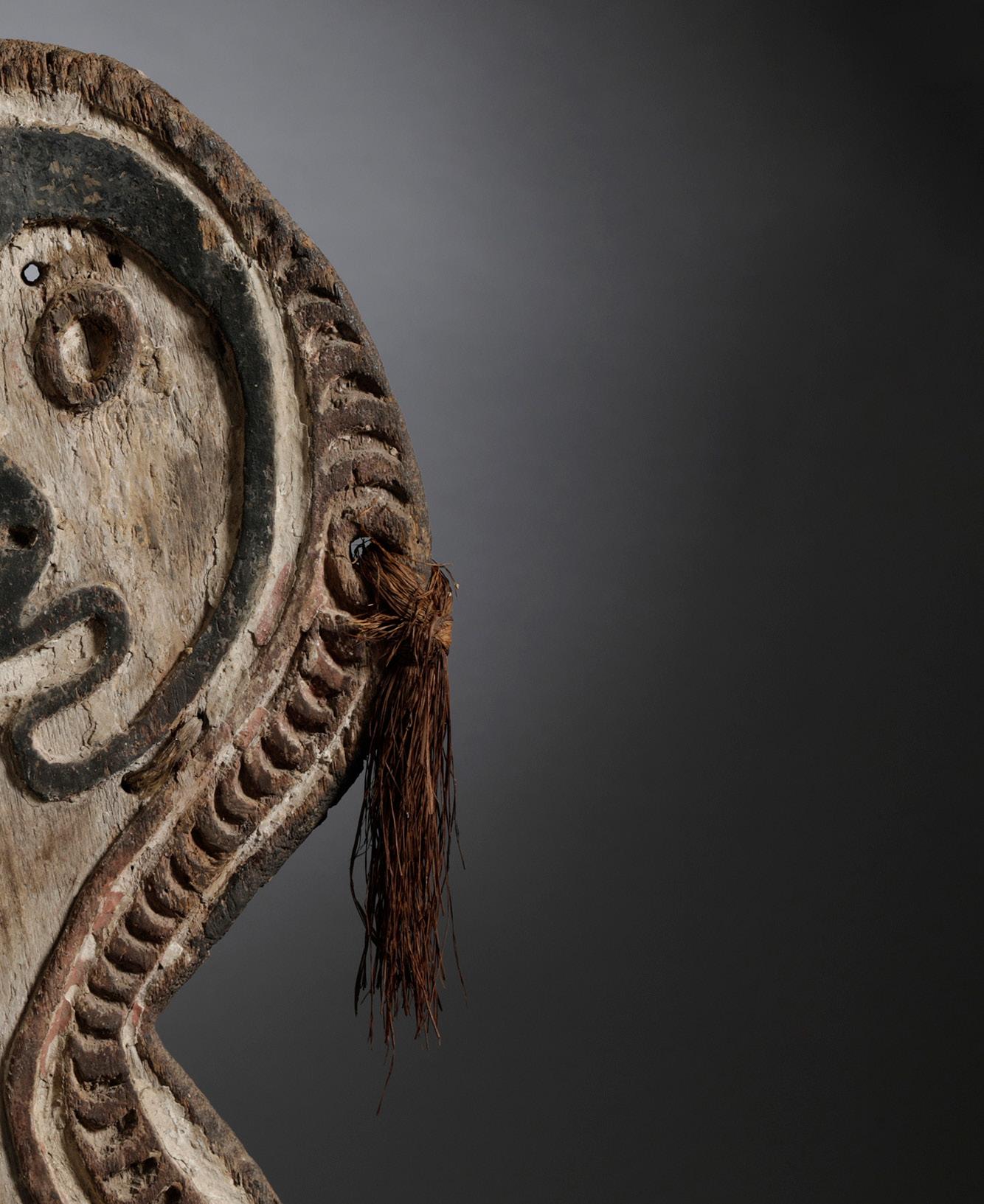

WHISTLE KASENGOSENGO
CHOKWE, ANGOLA
Late 19th century
Wood, glass beads
Height: 5 ½ in, 13 cm
PROVENANCE
Acquired from a missionary collection in Iowa in the 1950’s
Roy and Sophie Sieber Collection
PUBLICATION HISTORY
Robbins (Warren M.) and Nooter (Nancy Ingram), ‘African Art in American Collections, Survey 1989,’ Washington/London: Smithsonian Institution Press, 1989:551, #1505
Carved in ivory, horn, or wood, Chokwe whistles often bear miniature, stylized renderings of masks and figures. They were either worn as necklace pendants or tied to spears, and were used in the field by hunters to signal and respond to their party and to marshal their dogs. Their iconography
depicts ancestors, chiefs, or sacred beings, conferring a degree of status upon their carriers.
This beautiful whistle shows a finely carved partial figure with strong, stylized features and a ball-like torso. A delicate bead necklace encircles the neck; the mouthpiece protrudes from the top of the coiffure. Below the spheroid midsection is a crosspiece and flared base that allowed for the whistle to be bound to a tether. Two antelope horns protrude from the head, one of which is largely missing.

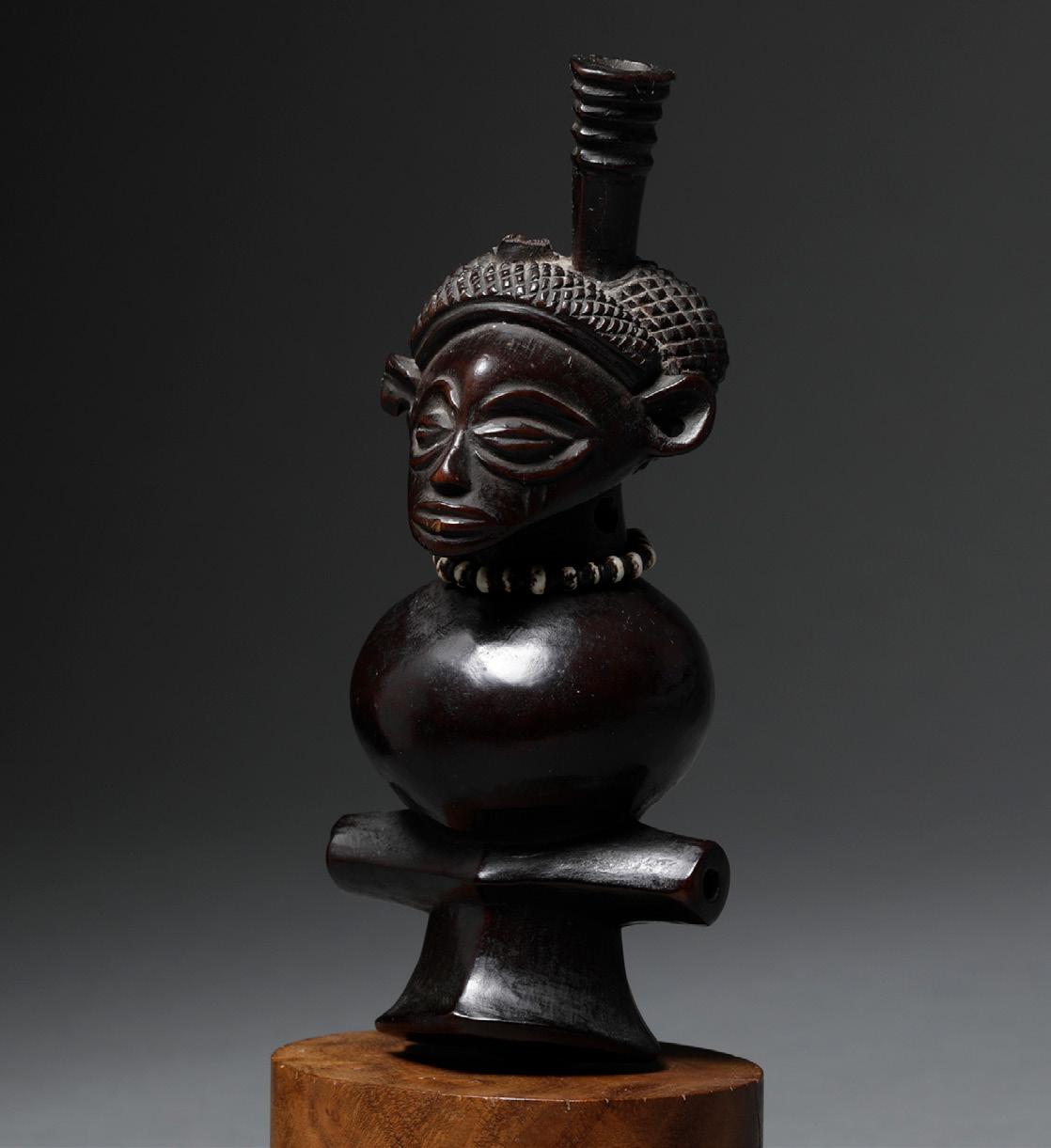

SORCERER’S IMPLEMENT ARHIYE KAIYAM
FLY RIVER, PAPUA NEW GUINEA
Late 19th/early 20th century
Crocodile tooth
Length: 4 ½ in, 11 ½ cm
PROVENANCE
Collected from a village on the lakes region between the Fly River and the border with West Papua near Lake Murray, Papua New Guinea, circa 1952
Private Collection, New Zealand c.1952–c.1985
John ‘Jack’ Charles Edler, Bloomington, IN, USA
Roy and Sophie Sieber Collection
Magical belief and practice were long deeply ingrained in Melanesian society, and echoes of them are still felt in the island complex in the present era. Traditionally, sorcery was used for both harmful and helpful ends, both of which might require the use of an enchanted object. Those who possessed the necessary expertise could create one through the application or insertion of powerful substances like blood or beeswax. In order to heal, a sorcerer could use a magical implement to find and return important things that were missing or stolen, such as the soul of a person afflicted with illness. Or, with harmful intent, they might utter a spell
over the item and symbolically ‘shoot’ it into a victim to bring sickness or death.
This is a very rare example of just such an implement. Shaped from a crocodile tooth, it is carved in the form of a stylized bird’s head, possibly a Papuan hornbill. The fusion of land, water, and air symbolism in this object possibly granted its user the ability to travel through and between both the physical and spiritual realms. For a similar example, possibly collected from the same village, see object number 61:2000 in the St. Louis Art Museum and featured in Tribal #101, August 2021.



MASK DEANGLE
DAN, IVORY COAST
Late 19th/early 20th century
Wood
Height: 8 ½ in, 22 cm
PROVENANCE
Merton Simpson Gallery, circa 1980
Roy and Sophie Sieber Collection
Dan masks are embodiments of gle or ge, spirits who wish to aid and communicate with human communities but who lack a physical form. Materialized in dream-inspired masks, they attain their desires through the medium of masquerade. The nature and form of both the mask and the dance are conceived by a member of the men’s Poro society, who may perform the dance himself. Gle are mysterious, unpredictable bush spirits with individual personalities and inclinations, and they are given names. Naturally unhabituated to the civilized sphere of the village, their chaotic aspect requires the presence of an attendant at the masquerade to control their volatile behavior and interpret their speech for the community.
Perhaps the most iconic Dan mask among Western collectors is known as dean gle. It is host to a benevolent spirit that seeks to teach and nurture, supporting peaceful
activities in the village. Dean gle is technically genderless, though its qualities of idealized beauty and gracious beneficence are often thought of as feminine by both the Dan and outsiders.
This example demonstrates the classic dean gle composition, with an oval face tapering down to a sharp chin, slit eyes set within a lateral depression, and a slightly open mouth with full lips set close below the nose. A vertical ridge in the center of the brow reflects a historical tattoo practice among the Liberian Dan. Facial proportions and details are finely rendered. High, double-row arched brows cut with incisions float above the eyes, contributing to the mask’s serene expression. Around the perimeter of the face is pierced a row of holes by which a coiffure of fiber or shells would have been affixed.



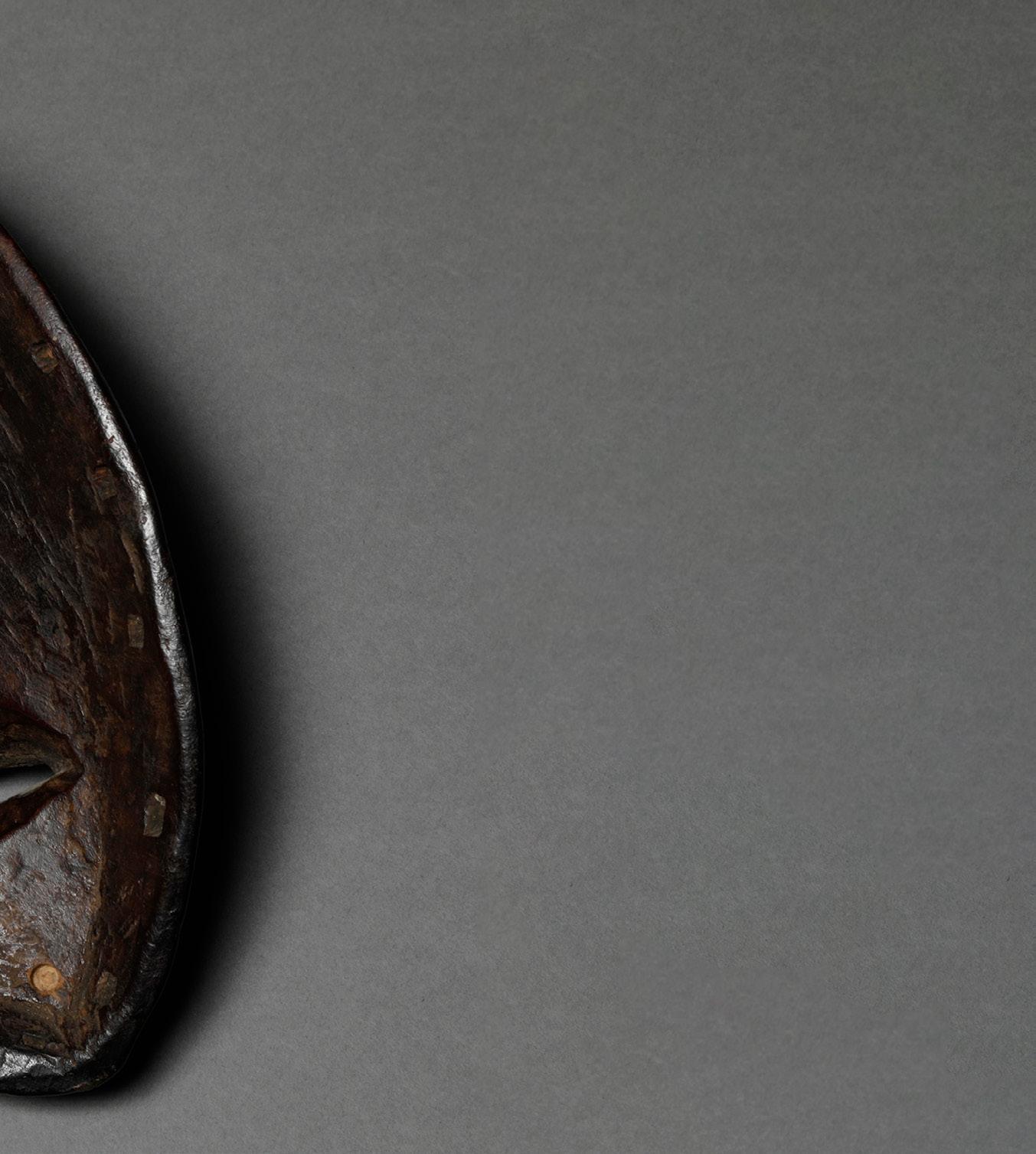

FIGURATIVE LIME SPATULA
TROBRIAND ISLANDS, PAPUA NEW GUINEA
19th century
Wood, pigments
Height: 11 ¾ in, 30 cm
PROVENANCE
Sieber family notes indicate that it was purchased in London around 1964 to 1967, probably from Ernest Ohly or Phillip Goldman.
Roy and Sophie Sieber Collection
The chewing of betel nut (Areca catechu) has been practiced across much of Asia and the Pacific for thousands of years. Wrapped in betel leaves (Piper betle) and mixed with lime, slices of the nut are chewed for the mild psychoactive and stimulating effect the mixture produces. A frequent and ubiquitous indulgence, many cultures have placed a significant degree of importance upon the chewing of betel nut, and have ascribed to it certain metaphorical and spiritual meanings. In the Solomon Islands, betel nut plays a role in gift-giving ceremonies such as betrothal and propitiatory offerings to spirits.
Melanesian artists applied a great deal of artistic energy to the production of betel nut paraphernalia, the most iconic of which is the lime spatula. This implement is used
to extract a dose of lime (made from burnt shells or coral) from a container to be added to the betel packet. The handles and finials of spatulas, which are sometimes quite large, are often carved with elaborate figural or abstract designs distinctive to the maker’s region.
This example is from the Trobriand Islands, now known as the Kiriwina Islands. It shows an exquisitely carved handle depicting a stylized humanoid figure in crouching posture, its body adorned with incised scrolling wave motifs. The tongue of the spatula extends downward in an elongated teardrop shape, growing elegantly from a narrow, delicate junction beneath the figure out to a paddle-like fullness. Old tag, partially illegible, reads ‘Isle of Savo Solomon’.




FIGURATIVE HEDDLE PULLEY KONO
GURO, IVORY COAST
Late 19th/early 20th century
Wood, string
Height: 7 ½ in, 19 cm
PROVENANCE
Roy and Sophie Sieber Collection
Heddle pulleys are used in strip-weaving, a process that produces long, narrow strips of cloth which are later sewn together to create a larger textile, such as a blanket. Heddles are arrangements of parallel cords or pierced panels that guide the weaver’s threads. They are used in groups and are tied together by a string that runs through a pulley situated above the loom. The weaver’s feet operate the heddles, alternately, during the weaving process.
Guro peoples and their eastern neighbors, the Baule,
are renowned for their textile arts. Strip weavers were able to set up their small, portable looms in public places, allowing passersby to admire their work. At the same time, the carvers who adorned the looms with decorative pulleys could also attract interest and potential commissions. Carved with exceptional sensitivity, figurative pulleys such as this one, which depicts a bust of an elegant woman with high coiffure, were a classic display of virtuoso carving skills for deft Guro artisans.


figurative heddle pulley kono

figurative heddle pulley kono


MINIATURE MASK
DAN, IVORY COAST
Late 19th/early 20th century
Wood
Height: 2 ¾ in, 7 cm
PROVENANCE
Roy and Sophie Sieber Collection
Most Dan face masks, and those of the culturally related groups of Côte d’Ivoire and Liberia, are commonly executed in a miniature form, ranging in height between six and twenty centimeters. Even the largest miniatures are too small to be worn in front of the face, and they rarely exhibit any means by which they may be attached to anything. The most common mask type represented in such diminutive form is dean gle (attractive mask with slit eyes, performs a feminine behavior) while the least common miniature forms are masks with tubular eyes and animal mouths.
Miniature masks bear many names: the most common is ma go (small head), but depending on scholarship it has also been named yi luo po (thing which water is poured over), gba po (thing which is fed), or nyonkula (substitute for the ancestors). Echoing the variety of names, they fulfill a variety of functions. Anyone who has a spiritual connection with a mask, or whose family owns an important mask, is entitled to commission a miniature. They are wrapped up and kept on the owner’s body or among their possessions and function as portable and personal forms that share the power and protective force of the full-sized mask. When a mask’s owner is traveling, the miniature mask serves as an important means of identification outside their immediate
community. This role may have given it the common appellation of ‘passport mask.’
Diviners can advise individuals to commission a miniature mask for preventative, protective, or curative purposes. Some scholars have stated that although women do not ordinarily have access to masks, those from families that have a strong connection to a specific mask may commission these miniature versions as a means of retaining ties to their own family identity after they marry.
In addition to being the property of one single individual, in certain instances maskettes may also play a communal role in secret societies. They are among the sacred objects displayed at men’s society meetings to protect the men collectively, and can be shown to new initiates. On these occasions they are interpreted to be representations of the benevolent spirits associated with the most important masquerades of the area.
Maskettes are also used as sacred objects for taking oaths and for swearing to tell the truth. They are often attached to other powerful objects such as leather pouches or antelope horns filled with medicines. In this context, their backs can also be stuffed with potent magical ingredients.
This fine maskette is of the classic dean gle type, showing the concave eyeline, slit eyes, tapered chin and protruding forehead of the well-known feminine image. The eyes are whitened and relief designs are present down the center line of the forehead and around the upper edge.



POWER FIGURE WITH KIFWEBE MASK NKISI
SONGYE, DRC
Late 19th/early 20th century
Wood, horn, fur, pigments
Height: 10 ½ in, 27 cm
PROVENANCE
Thomas S. Alexander III (1942-2021), Saint Louis, MO/Portland, Oregon, USA
Roy and Sophie Sieber Collection
Songye sculptors are recognized for their vibrant carving traditions, particularly their powerful and immediately distinctive masks, known as kifwebe. These striated masks, with their exaggerated, abstract features and projecting mouths, belong to the iconic pantheon of African art forms for Western collectors. They served as emissaries of the ruling elite and related to a complex and esoteric knowledge of magic-working that influenced social control.
But masks were only one element of the Songye art corpus. Like neighboring tribes in the Congo, the Songye employed a range of power objects that were as important to their belief systems as their masks. Power figures (sin. nkisi, pl. mankisi) were a major class of carvings that were used to combat malevolent magic, promote fertility and success, and embody the force of good. Granted great potency
through the workings of an nganga, or magic practitioner, they were adorned with an assortment of empowering items called bajimba. These included horns, skin, feathers, teeth, beads, hair, fiber, tacks, and other materials. Though mankisi were benevolent, they were considered dangerously powerful and were often not touched directly.
The carver of this nkisi has compressed the body to an abstract, roughly columnar shape, devoid of limbs and wrapped in bundles of fur. An expressive face shows direct reference to the design of the striated kifwebe mask, with large eyes and a mouth held open as if in mid-speech. A prominent horn is implanted vertically in the top of the figure in the same fashion as larger mankisi, contributing to its magical efficacy.

figure with kifwebe mask nkisi
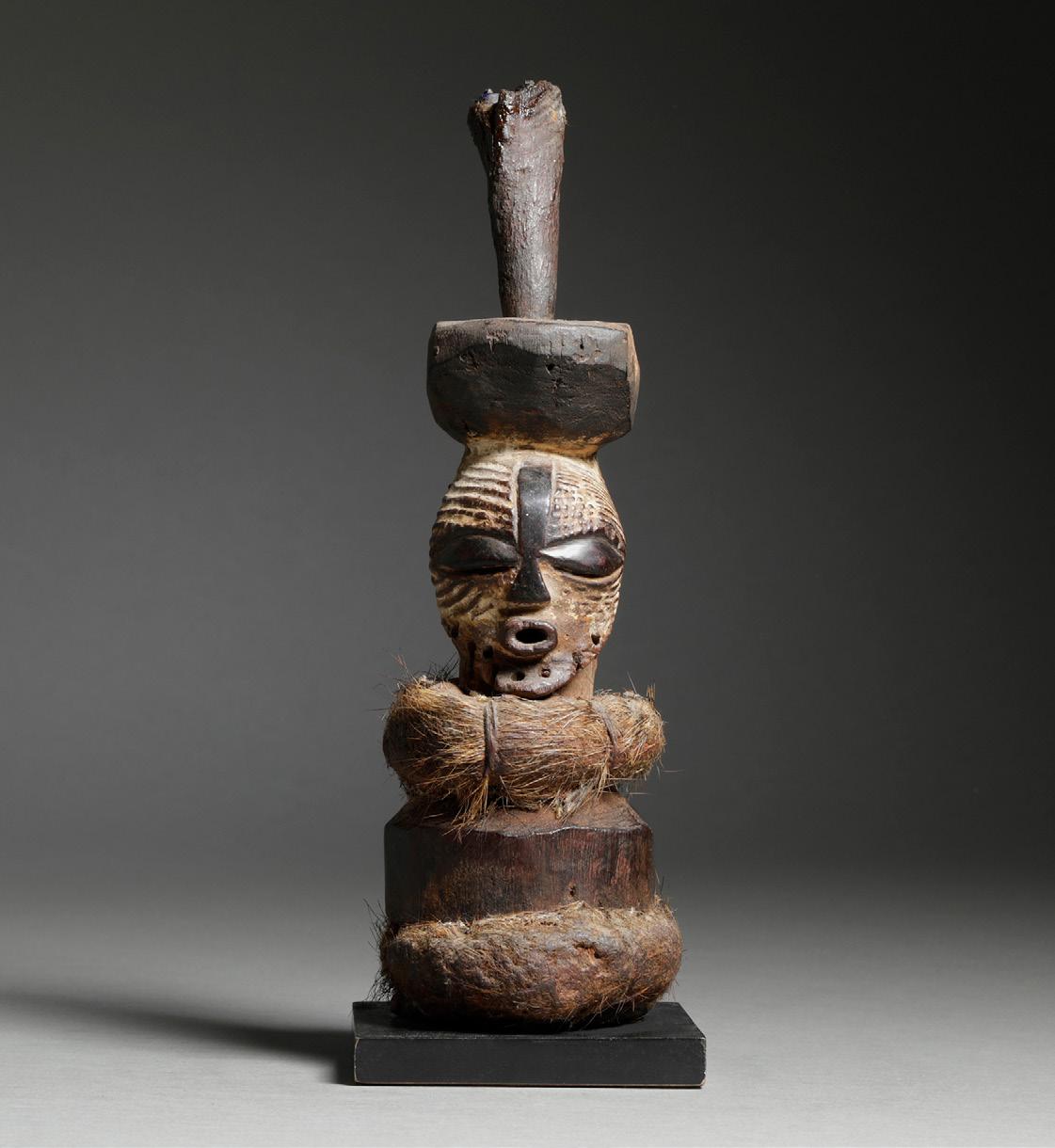



ADZE
KANAK, NEW CALEDONIA
18th – 19th century
Hard red wood, nephrite blade, coconut sennit
Height: 9 in, 23 cm
PROVENANCE
George Juergens, The Old Curiosity Shop, New York
Roy and Sophie Sieber Collection, acquired from the above in the mid-1960s A stunning example of a hand-carved hardwood adze with a bulbous central body, exhibiting sumptuous caramel and coffee hues. Protruding from the lower portion of the body is a tapered ovoid handle, wrapped at the junction with braided sennit fiber. A tongue-like blade of mottled nephrite is wedged tightly within the forked gap of the head, around which substantial lengths of sennit fiber cord are wrapped to clamp the blade inside. Its robust form – compact, curvaceous and graced with smooth and lustrous surfaces –
suggests a vigorous muscularity and tight sculptural energy. Adzes like this one were among the most important tools in pre-contact Polynesia and Melanesia. They were used for a variety of utilitarian and agricultural practices, but the ceremonial nature of the nephrite blade makes this example truly exceptional. Nephrite was typically used for adzes meant to embody chiefly authority, and their power was derived from the earth which the adze would move. In good condition with original blade and sennit binding.



FETISH OBJECT FOR A SECRET SOCIETY
LEGA, DRC
Early 20th century
Wood
Height: 6 ¼ in, 16 cm
PROVENANCE
Roy and Sophie Sieber Collection
Much of the art in the Democratic Republic of the Congo was historically created for esoteric associations of men and women, such as the Bwami society of the Lega. Bwami beliefs are pervasive in all aspects of life, shaping individual growth and governing social relations. Masks, heads, and figurines made of wood and ivory are involved in initiatory rites for the society’s highest grades, and their multilayered symbolism is unfolded through a range of performances.
Many Lega objects are adorned with dotted-circle motifs, body markings that enhance and beautify the carvings. In Lega belief, physical beauty and morality are inseparable,
and the polished, ennobled surfaces of these items references the spiritual perfection of the Bwami initiate. While many Bwami objects are clear in their depictions, some forms are more abstruse. This unusual wood carving shows an abstract face with narrow eyes, similar to Lega mask designs. It is attached to a segmented suggestion of a body, lending the piece a zoomorphic or worm-like character. The face and middle segment are covered with a multitude of small pits that recall the dotted circle motifs of the Bwami.


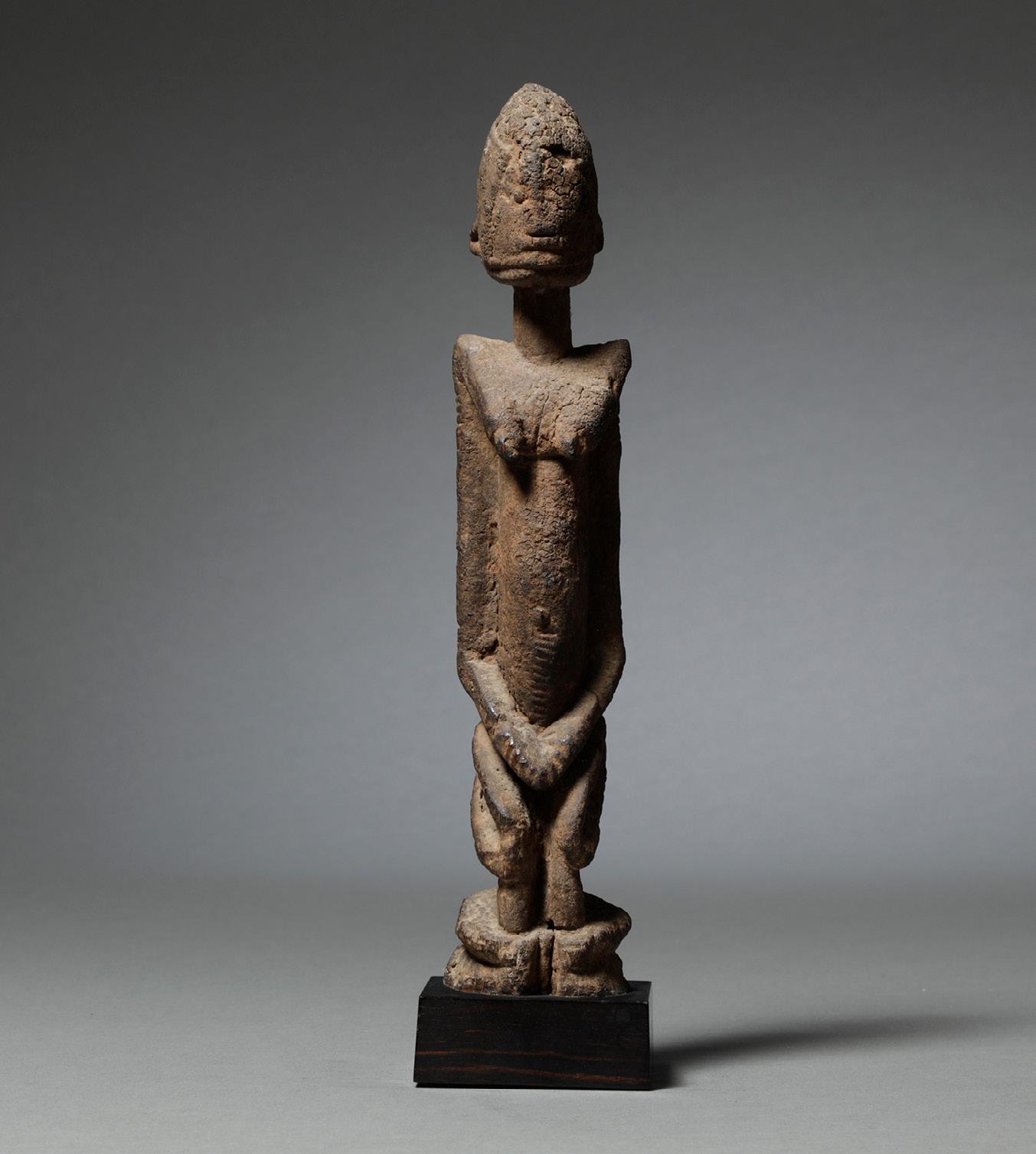
KNEELING FEMALE SHRINE FIGURE
DOGON, MALI
19th century or earlier
Wood, encrusted surface
Height: 10 ½ in, 27 cm
PROVENANCE
Roy and Sophie Sieber Collection
The Dogon people settled in present-day central Mali, between the Niger River and the border of Burkina Faso, sometime around the fifteenth century, establishing themselves in cliff dwellings beneath the Bandiagara Escarpment. Their sculptural tradition was heavily influenced by the Tellem, the Bandiagara culture who the Dogon displaced when they arrived beneath the cliffs. Dogon art was often religious in nature, and figures were housed reverently in shrines to support the flourishing of the land and the community. Sculptures were often created by blacksmiths, who were honored in Dogon society, and were used for ritual and initiatory purposes.
Tall, slender figures with columnar bodies and ovular or columnar heads are one of the iconic Dogon types. This female figure shows a long torso and arms, raised angular shoulders, and a bullet-shaped head on a slim neck. It displays qualities considered highly desirable in Dogon women – knees bent in suppliant deference, downcast eyes and hands modestly clasped, displaying self-control and propriety. The expanse of the abdomen creates a strong
focal point, suggesting the power for childbearing. Facial features and the surfaces of the body on the whole are richly encrusted and eroded, enhancing the figure’s symbolic connections to the earth, fertility, and ancestral history. The female figure is represented wearing a lip plug. Among the Dogon people of Mali, lip piercing holds significant cultural and symbolic meaning, particularly for women. The practice involves inserting rings into the lower lip, a tradition that begins in early childhood. At around the age of three, Dogon girls have their lower lips pierced, and a small ring is inserted. This initial piercing symbolizes the introduction of speech, marking a child’s entry into the realm of communication. In contrast to other African cultures where lip plates are often used, the Dogon practice focuses on the insertion of plugs rather than large plates. This distinction highlights the unique cultural significance of lip piercing among the Dogon, where the emphasis is on the symbolic aspects of speech and communication rather than aesthetic or social status markers






STANDING FIGURE WITH UPRAISED ARMS
TELLEM, BANDIAGARA ESCARPMENT, MALI
Circa 11th – 15th century
Wood, encrusted patina with sacrificial material
Height:18 in, 46 cm
PROVENANCE
Acquired in the 1970’s in New York City, probably from J.J. Klejman
Roy and Sophie Sieber Collection
PUBLICATION HISTORY
Robbins (Warren M.) and Nooter (Nancy Ingram), ‘African Art in American Collections, Survey 1989’, Washington/London: Smithsonian Institution Press, 1989:55, #13.
The Bandiagara Escarpment is a range of sandstone cliffs that reaches across present-day central Mali between the Niger River and the border of Burkina Faso. Rearing up more than 1,500 feet in some stretches, the ridges provide a natural barrier against hostile incursions as well as many natural shelters that have preserved the wood sculptures produced by generations of successive, interrelated cultures.
The Dogon people, after leaving their homeland in Mali, arrived in the Bandiagara region sometime around the fifteenth century. They developed settlements of cliff dwellings in the shadow of the escarpment, and the existing inhabitants they met as they occupied the area they called tellem (‘we found them’), a term that now describes the region’s pre-Dogon culture and sculptural style. A portion of the Tellem population may have fled upon the arrival of the Dogon, while some were integrated into the incoming
society. The Dogon assimilated not only the Tellem’s people but also their art – they appropriated certain Tellem sculptures and used them for their own ritual purposes, claiming the power of the figures in the process.
What followed was a period of artistic fusion between the two groups’ traditions that poses a degree of difficulty when distinguishing clear attributions in Bandiagara objects. However, Tellem figures are known to share certain attributes: a tall, narrow form with short bent legs, columnar torso, and large columnar head. They frequently show vertically raised arms fused to the head, typically with joined hands, and they are often fully encrusted with organic material, obscuring the figure’s features and original details but endowing them with a striking sense of ritual power.
This fine example stands in the classic pose, hands joined at the apex, its silhouette slightly swaying with a sense of vitality encased within great age. Features are vaguely discernible beneath the extreme encrustation, including a bearded face and a stacked succession of breasts, belly, umbilicus, and genitalia. The melange of anatomical characteristics appears to depict a hermaphroditic image.
The raised arm stance is an iconic trademark of works from the Bandiagara. According to Hélène Leloup, ‘the statues with raised arms form part of a group of statuettes of different styles found all along the cliffs: Djennenke, classical Tellem, Niongom and Komakan. These figures played a role in rainmaking rites performed by all the different inhabitants of the cliffs: a cultural adaptation by osmosis responding to the chronic lack of rain along the dry cliffs.’ (Leloup, Dogon, Paris, 2009, p. 127).

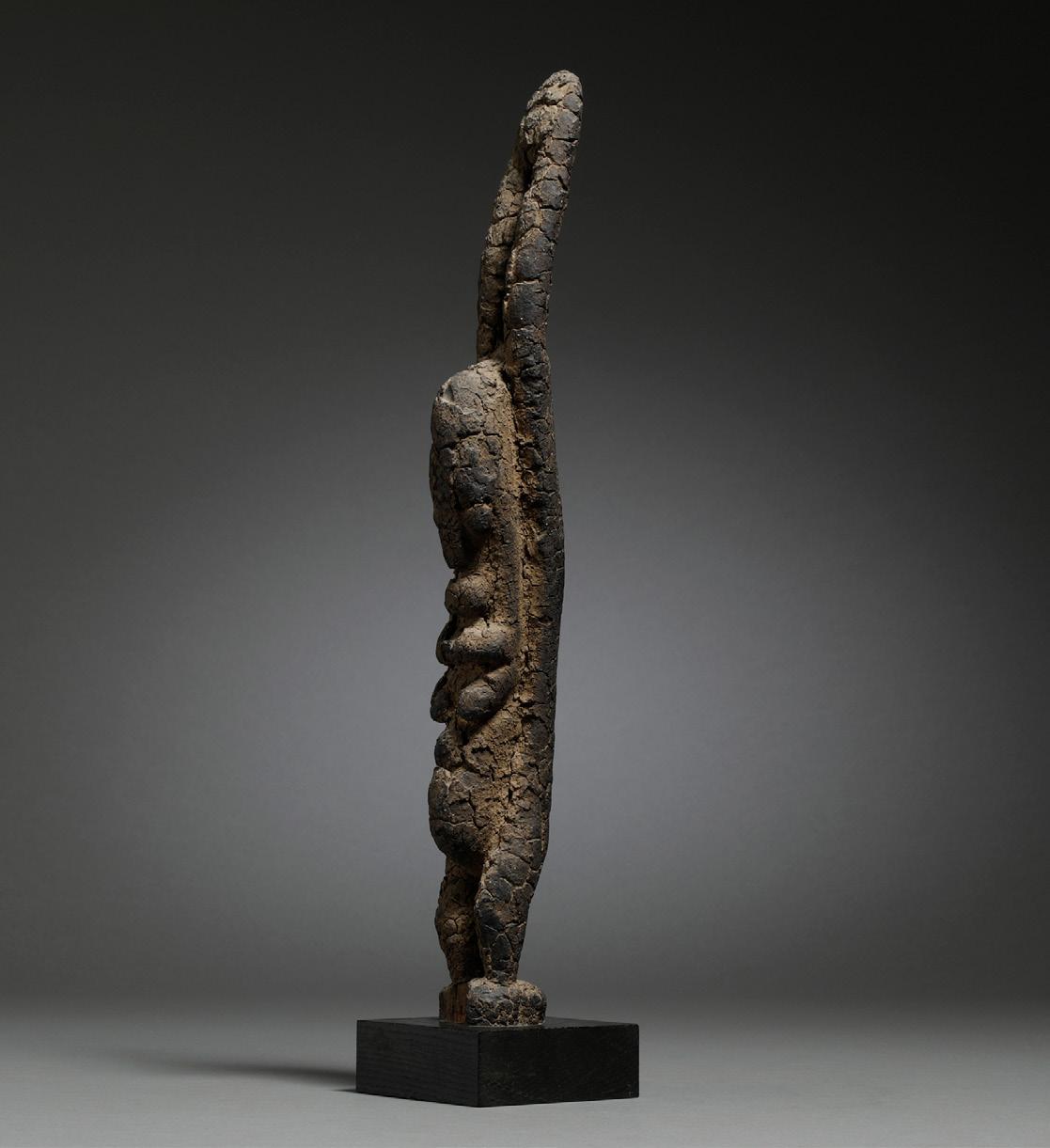
standing figure with upraised arms



SHIELD
ASMAT, NEW GUINEA
Late 19th/early 20th century Wood, pigments
Height: 43 in, 109 cm
PROVENANCE
Roy and Sophie Sieber Collection
The Asmat of New Guinea are known for their vibrant woodcarving traditions as well as their historical culture of headhunting, each of which influenced the other. Body shields (jamasj) were among the most important and iconic carvings carried by Asmat warriors in their perpetual raids upon neighboring tribes. The purpose of such raids was to claim heads – potent sources of power, prestige, and magic – and to avenge deceased relatives who had fallen in past battles. Jamasj directly embodied the spirit of one of the warrior’s fallen relatives, and the spirit accompanied the fighter in combat. Before a raid, the shields were carved and presented to the battle group at a special feast, where the shields were faced east (the direction of the Asmat afterlife) to welcome in the spirits.
Asmat shields were often elaborately carved with repeating motifs and extensive relief work, and vibrantly colored. They employ abstract iconography relating to ancestral and martial symbolism, sometimes involving human features and representations. This example shows an organic system of serpentine bands and grasping hook forms, pigmented in the striking white and rust-red ochre scheme that is common for jamasj. A border of more finely detailed motifs lines the vertical edges. The pair of river-like bands at the top of the shield, the motion of which mirrors each other, may depict an abstract face. The rear of the shield still retains its original paint.


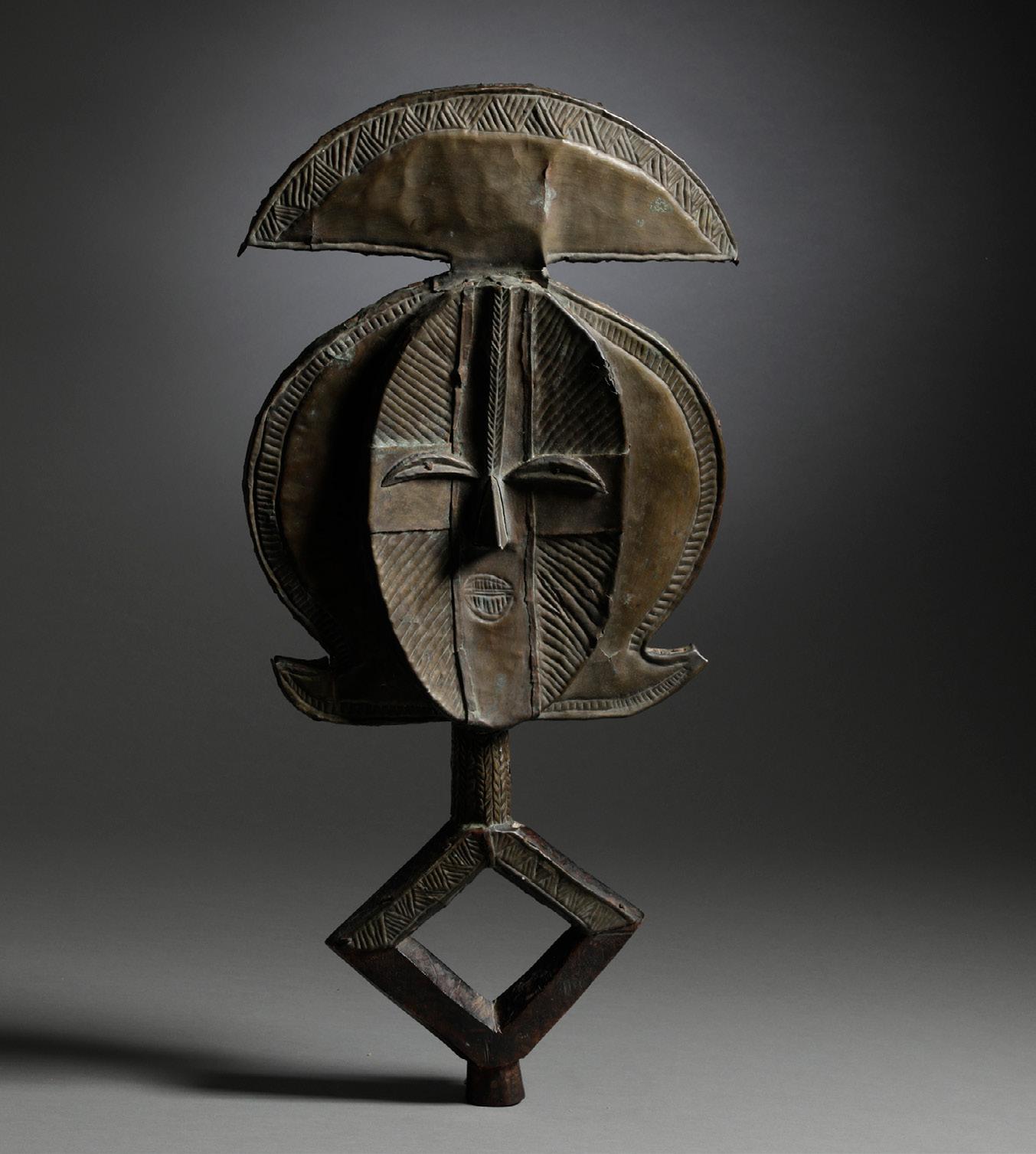
RELIQUARY GUARDIAN FIGURE
KOTA, GABON
Late 19th/early 20th century
Wood, copper, nails
Height: 25 in, 64 cm
PROVENANCE
Jeanne Herron Richards (1923–2002). Richards worked primarily as a printmaker and painter and acquired this figure in Paris in 1954 while on a Fulbright scholarship to France.
Roy and Sophie Sieber Collection
Until the middle of the twentieth century, clans across equatorial Africa preserved the memories and spirits of revered ancestors through reliquaries that held the skulls of the renowned and distinguished. Elders of the widespread ancestor cult (most widely known as bwiti or bwete among Kota peoples in areas now belonging to Gabon and the Republic of Congo) commissioned the creation of abstract figural sculptures (mbulu ngulu) that stood atop baskets or bark containers that housed these precious relics. Produced in a variety of styles, they were affixed to the lid of the reliquary container or lashed to a relic bundle placed inside. On a superficial level they acted as the public face of familial altars, but they served a much more complex and important role as agents of ancestral power in communal rites and
ritual performances, channeling support and protection to the community.
This magnificent example shows classic, elegant shapes and a resplendent aura. The convex face plate identifies this as a female figure. Mild, crescent-shaped eyes and an open mouth present a benevolent mien that communicates welcoming assurance. Extensive hatching in the center and around the borders activates and unifies the segmented brass surfaces. Beneath the head, a short neck connects to a diamond-shaped openwork base, all similarly adorned with impressed designs. The metal sheets that jacket the figure were sourced from European traders and would originally have shone with great brilliance.





HEADDRESS NGAMDAK
JABA OR KORO PEOPLE, NIGERIA
First half 20th century
Wood, pigments, wax, seeds, fiber
Height: 17 in, 43 cm
PROVENANCE
Roy and Sophie Sieber Collection. Collected by Roy Sieber during his expedition to Nigeria in 1958.
EXHIBITION HISTORY
New York, USA: ‘Sculpture of Northern Nigeria from the Roy Sieber Collection,’ The Museum of Primitive Art, 18 November – 31 December 1961, #33
PUBLICATION HISTORY
Sieber (Roy), ‘Sculpture of Northern Nigeria,’ New York. Museum of Primitive Art, 1961: 31, fig. 36 (as Jaba)
The Koro of Nigeria create headdresses such as this one for themselves and for neighboring tribes, including the Ham (Jaba) and possibly the Kagoro, Kaje and Kamantam. Similarities in their respective religious and artistic traditions suggest a close connection in origin, and the mask is the primary link, representing a tribe’s ‘mother spirit.’
According to William Fagg, these remarkable head crests, which in appearance seem almost half headdress, half mask, appeared at spring and autumn festivals in the home region of the Koro. After a succession of masquerade dancers
depicting bush spirits, animals, and hunters had performed before the community, ‘a troupe of dancers representing the able-bodied young men of the tribe with abstract headpieces danced vigorously around two tall figures, the mother spirits with turreted headdresses and dressed in great tent-like painted fiber gowns. They would twirl around so that the gowns filled out majestically, and every few minutes would envelop one of the young men in a motherly embrace. Thus was the benevolence of the ancestors sought for the work of the year.’
The enigmatic, enchanting form of this maternal image shows an arched shape straddling a central column, suggesting the shape of an abstract, faceless head. Gridded grooves highlighted with white provide a ghostly perimeter that drapes the head like a veil. The neck and inner arch of the ‘face’ area are richly textured with a profuse covering of red abrus seeds, portions of which have been lost, leaving a pitted and earth-like surface.

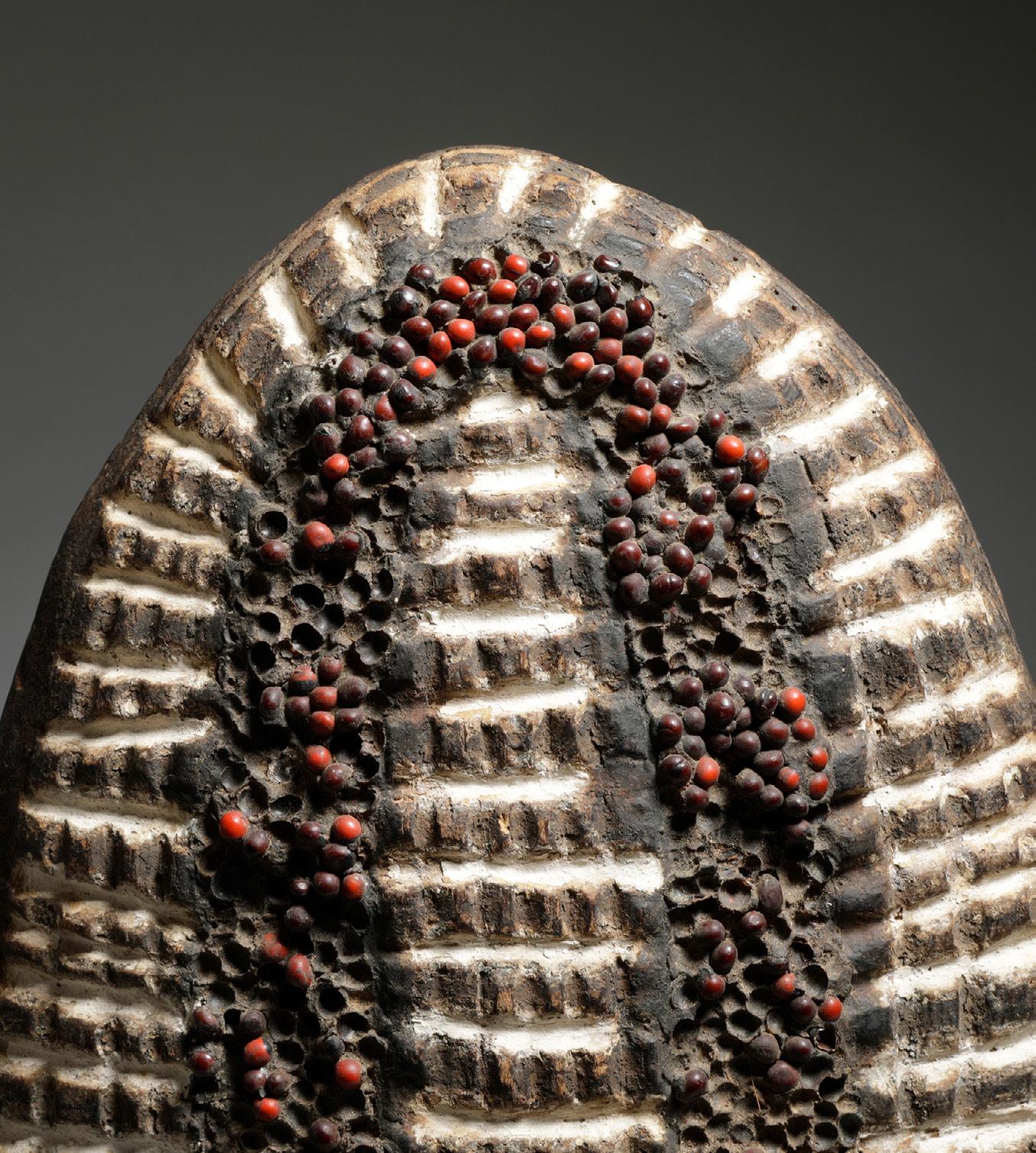

FLUTE STOPPER
SEPIK RIVER, NEW GUINEA
Late 19th/early 20th century
Wood, shell eyes, natural fibers
Height: 8 in, 20 cm
PROVENANCE
Roy and Sophie Sieber Collection
In the cultural traditions of New Guinea, flutes often serve more than a musical purpose. They make their voices heard in a wide range of ritual contexts, including initiation ceremonies and harvest celebrations. The sound of the flute speaks for the ancestors and the spirits of nature, carrying blessings for the community and heralding experiences of transition.
Knowledge regarding the construction, playing, and sound symbolism of flutes is an esoteric practice guarded by secluded men’s societies. Among these secrets is a sphere of understanding around flute stoppers, which are critical components used to beautify the instrument
and modify its sound. Stoppers are prized objects that are often passed through numerous generations as heirlooms. Elaborately carved in wood, clay, bone, and bamboo, they often depict metaphysical subjects – ancestors, totemic animals, mythological characters – and embody the connectedness of the player and the community with the realm of the spirits.
This is an old cephalomorphic stopper likely dating to the nineteenth century. It presents a striking visage with shell eyes set beneath weighty brows, defined cheeks, and a long, sharp nose with flared nostrils. The surface is richly textured, and lengths of cordage remain attached at the ears.


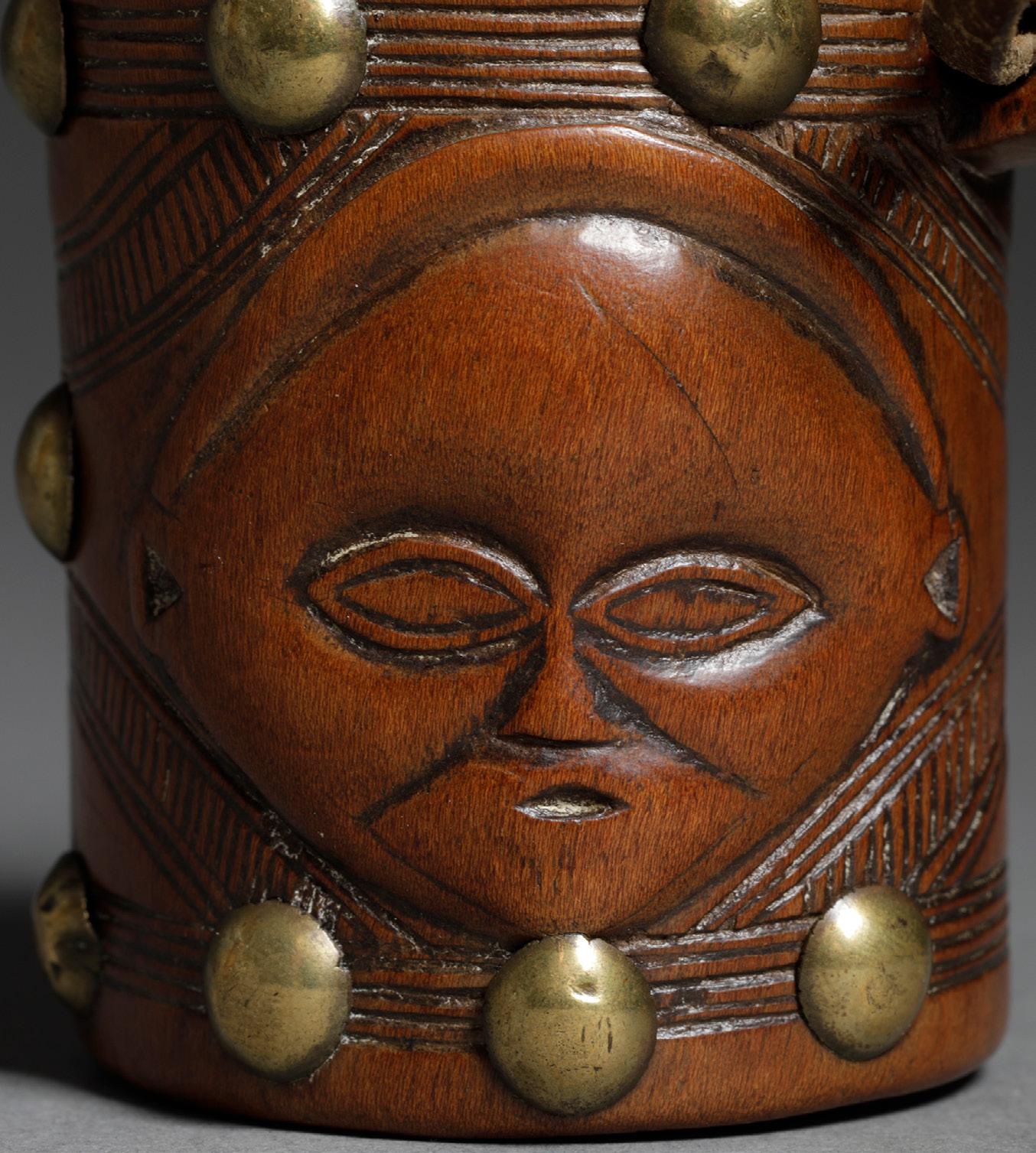
SNUFF CONTAINER/ MORTAR TESA YA MA KANYA
CHOKWE, ANGOLA
Late 19th/early 20th century
Wood, leather, brass tacks
Height: 2 ½ in, 6 cm
PROVENANCE
Sotheby’s London, December 11, 1978
Roy and Sophie Sieber Collection
This beautifully designed snuff container, which doubles as a tobacco mortar, shows brilliant workmanship and a warm, sumptuous patina. Finely incised lines and hatching surround a wide central face with almond-shaped eyes and a prominent brow. Its features gently indent the surface in a subtle relief effect. A cylindrical stopper is tethered to the body of the mortar by a leather strip and lug. Shiny brass tacks are utilized as decorative accents. During the nineteenth century, tacks of this kind were obtained through trade with European merchants and were quite costly in Chokwe communities. Thus they were associated with affluence and high social rank, and were often used liberally when incorporated into a design.
Tobacco had a similar connection to status in Chokwe culture, and was reserved for elders and for men and women of privilege. Smoking tobacco and inhaling it as snuff was both a ritual and social practice among many peoples of sub-Saharan Africa. In Chokwe society, tobacco was used on ceremonial occasions to facilitate communication between revered ancestors, guardian spirits, and the living community. In these complex and sometimes overlapping contexts, tobacco paraphernalia carried layers of meaning that made them precious and symbolically charged objects.


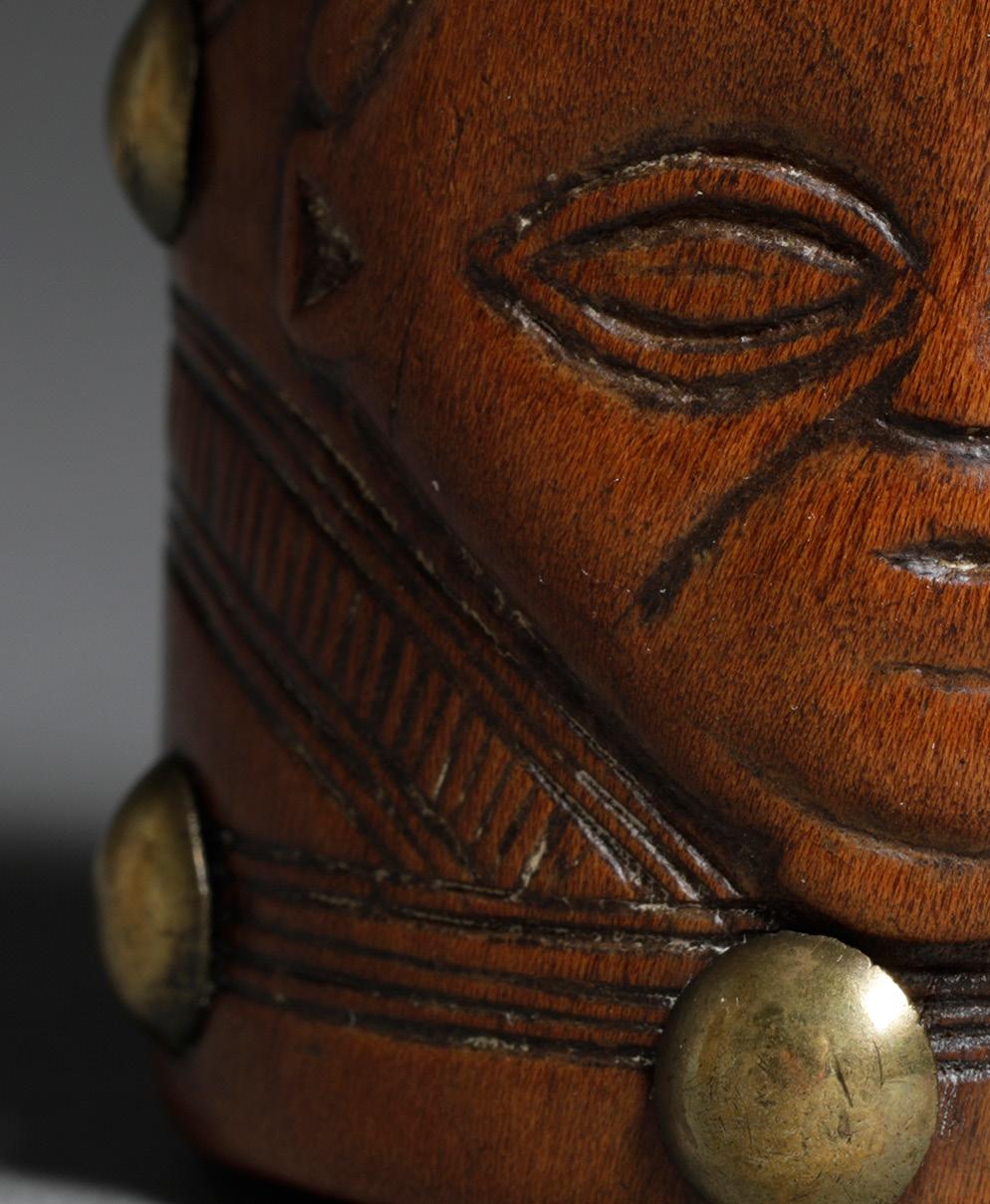


RELIQUARY GUARDIAN FIGURE MBULU NGULU
KOTA, GABON
19th century
Wood, copper, iron
Height: 11 in, 28 cm
PROVENANCE
Julius Carlebach (1909–1964), 1958
Chet La More (1908–1980). Prof. La More was an artist and collector. He taught at the University of Michigan from 1947 until 1974.
Roy and Sophie Sieber Collection
Until the middle of the twentieth century, clans across equatorial Africa preserved the memories and spirits of revered ancestors in the form of reliquaries that held the skulls of the renowned and distinguished. Elders of the widespread ancestor cult (most widely known as bwiti or bwete among Kota peoples in areas now belonging to Gabon and the Republic of Congo) commissioned the creation of abstract figural sculptures (mbulu ngulu) to stand atop baskets or bark containers that housed these precious relics. Produced in a variety of styles, they were affixed to the lid of the reliquary container or lashed to a relic bundle placed inside. On a superficial level they acted as the public face of familial altars, but they served a much more complex and important role as agents of ancestral power in communal rites and ritual performances, channeling support and protection to the community.
Combining wood and metal in a semi-figural composition, Kota reliquaries represent a rather unique African tradition. The costly metals that form their dramatic
faceplates served to repel evil spirits and communicated social prestige. Their variously concave and convex faces also hold meaning about their identities, concave faces being reputedly female and convex faces male. A range of styles mark the faces’ rendering, but most are highly abstract and sometimes lack any features but eyes.
This small, rare reliquary shows an expressionistic face with striking gaze, textured with rifts and native repairs that lend the sculpture a storied, personal, vaguely brooding aura. Its form is somewhat simplified and reduces the composition to two pieces, a crescent-shaped head plate and large lower face, with staring eyes set in the shadow of the heavy brow and a slender nose joining the two sections. The suggestion of an open mouth is impressed at the bottom of the face. Decorative patterns of pierced holes adorn the main sections of the head, enhancing the tactile quality of the aged metal.
Beginning in the 1870s, Kota reliquary figures were among the earliest African sculptures to be acquired by European naturalists and explorers, among them Paul Du Chaillu, Alfred Marche, Oscar Lenz, and Pierre Savorgnan de Brazza.



WHISTLE
NUNA OR BWA, BURKINA FASO
Late 19th/early 20th century
Wood, metal
Height: 21 in, 53 cm
PROVENANCE
Roy and Sophie Sieber Collection
Wooden whistles served a range of uses across various cultural groups in West Africa during the nineteenth century. Both practical and musical implements, they were a means of communication and signaling over distances during hunts, and provided musical accompaniment for social and royal functions, often in group performances. They also had metaphorical and ritual significance. In some ceremonies and rituals, whistles play a role in calling upon spirits or honoring ancestors. They can be seen as tools to connect the physical and spiritual realms, particularly in initiation rites or other important life events.
In Burkina Faso, music is central to cultural life, and whistles are often integrated into musical performances. They add rhythm, accentuate dance movements, and can be played alongside drums, balafons, and other traditional instruments during festivals, celebrations, and ceremonies. This elegant wooden example features a slender body with a resonating bulb and diamond-shaped finial at opposing ends. Brass cuffs encircle the whistle at four points along its length, and the surface of the bulb is decorated with applied brass pieces of circular and hourglass shape.



HEAD OF A MAN
EDO, BENIN
19th century or earlier
Bronze
Height: 1 ½ in, 4 cm
PROVENANCE
Roy and Sophie Sieber Collection
The Edo people of Benin are renowned for their exceptional craftsmanship in bronze, which is a core part of their rich artistic heritage. The use of bronze among the Edo dates back to the 13th century, with the art form reaching its height between the 15th and 17th centuries.
The earliest known bronzes from Benin date to approximately the 13th century, coinciding with the establishment and consolidation of the Benin Kingdom. The art of bronze casting is believed to have been influenced by earlier West African metalworking traditions, although Benin developed its own distinctive style. Bronze casting in Benin was historically tied to the Oba (king) and the royal court. The Oba commissioned the guild of bronze casters, known as the Igun Eronmwon, which remains active today. Membership in this guild was hereditary and highly respected. The casters lived and worked near the palace in Benin City.
The Edo artisans used the ‘lost-wax’ casting method, a complex and sophisticated technique where molten metal is poured into a wax mold that is then melted away. This process allowed for detailed and intricate designs, which became hallmarks of Benin bronzes. The bronzes served both ceremonial and historical purposes. They were often created to honor the Obas and other notable figures and to commemorate significant events in the kingdom’s history. Plaques depicting court scenes, warriors, and historical events adorned the walls of the royal palace. Many bronzes also had a spiritual function and were used in religious rituals. Some depicted deities, royal ancestors, or other significant figures, serving as a bridge between the physical world and the spiritual realm.
This finely cast head, possibly used as an amulet or goldweight, has an elaborate coiffure and shows significant age.





FIGURE BIOMA
PAPUAN GULF, PAPUA NEW GUINEA
19th or early 20th century
Wood, pigments
Height: 20 in, 51 cm
PROVENANCE
Roy and Sophie Sieber Collection
Along the shores of the Gulf of Papua on the southeast coast of Papua New Guinea, religious and artistic life was historically centered upon powerful spirits called imunu These were nature spirits that were closely associated with specific locations in the local landscape, and they were intimately linked to the clan who shared their territory.
Papuan Gulf wood sculpture is primarily twodimensional and typically shows details and features worked in low relief. Two of the region’s main classes of carvings are gope, oblong panels with vaguely humanlike designs, also known as spirit boards; and bioma, stylized figural images that are more clearly anthropomorphic. These objects
acted as both depictions of and dwelling places for specific imunu. Communal men’s houses (ravi) contained numerous clan shrines that were home to the spirit boards, figures, and other sacred objects connected to the clans’ respective imunu.
This fine bioma shows a humanoid silhouette with mushroom-shaped head and neck, distended belly, and small, curved arms and legs. Characteristic of many imunu images, the face bears an agreeable expression of seeming kindness, showing benevolence to its clan. The wide eyes are watchful, implying a ready and preternatural awareness.

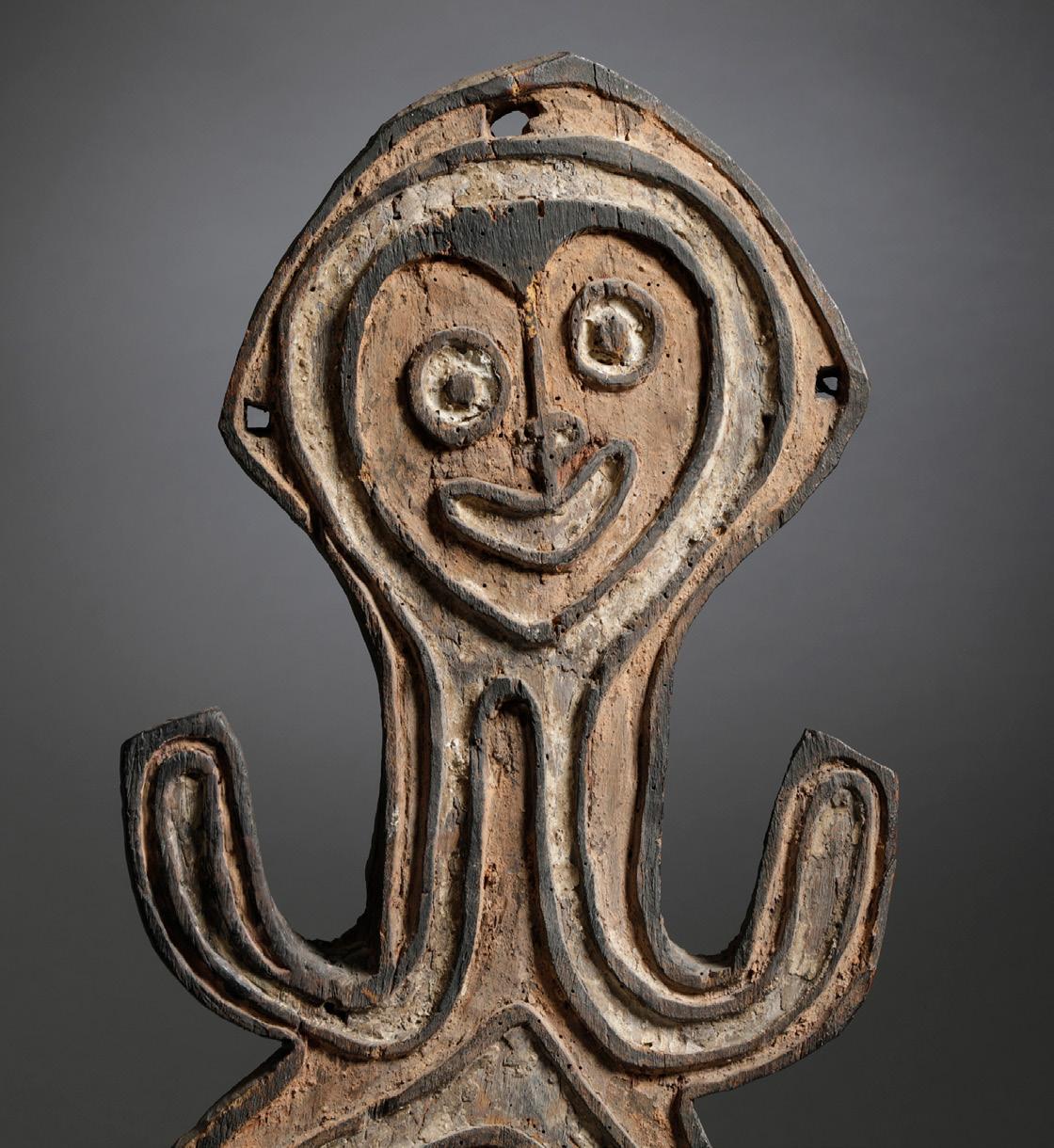

HEADREST MUTSAGO
SHONA/TSONGA, ZIMBABWE
Late 19th/early 20th century
Wood
Height: 6 in, 15 cm
PROVENANCE
Roy and Sophie Sieber Collection
Among the cultures of South Africa, wood carving was produced by men, and the imagery they incorporated into their works reflected their particular concerns. Meat dishes, milk pails, headrests, and staffs held allusions to the cattle men raised and the ancestors they revered.
Headrests were believed to provide a vital link between the living and the spirits of their ancestors by way of dream communication. The rests, which were frequently carved in imaginative and elaborate designs, embodied and enabled this metaphysical support offered by a man’s forebears. They were both common and precious, utilitarian and spiritual. Headrests often formed a part of a bride’s dowry, creating an important connection between her own ancestors and her new husband’s line.
Fine workmanship and imaginative composition distinguish this Shona headrest, which integrates a full ungulate figure (possibly an antelope) and a three-columned rest. Deftly executed triangular motifs adorn the surface of the rest and the flanks of the animal, and are echoed in the conical shape of its stout legs. Clear animal iconography such as this is rarely seen in headrests, suggesting this special piece was carved for a person of high status.
For an example by the same hand, see Royal Museum for Central Africa, Tervuren, Belgium collection number EO.1980.2.481 ex Marie-Jeanne Walschot (1896-1977), Brussels, Belgium.


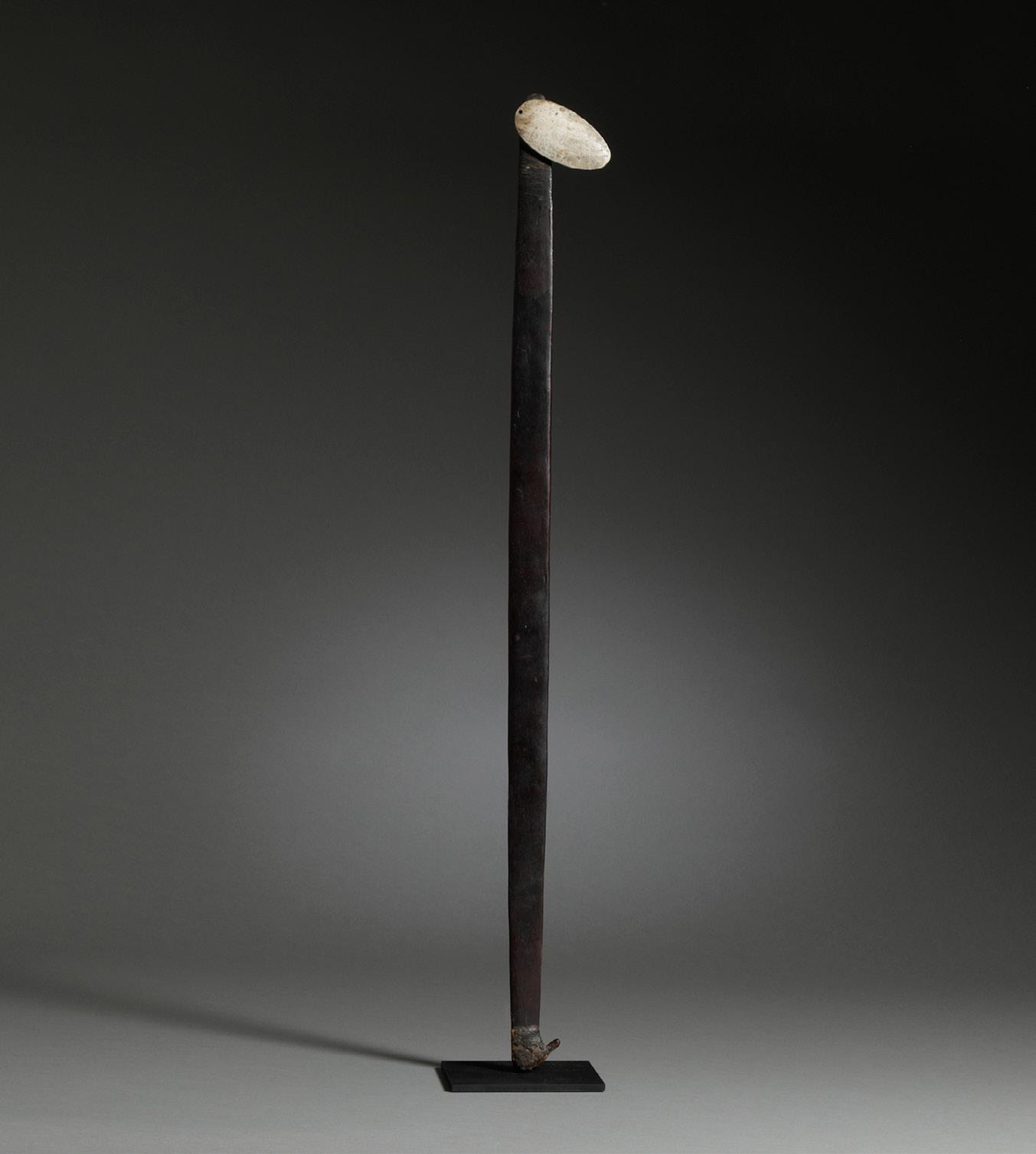
SPEAR THROWER WOOMERA
WATHATHI PEOPLE, AUSTRALIA
19th century
Casuarina wood, resin, shaped head of Baler shell.
Height: 36 in, 91 cm
PROVENANCE
Roy and Sophie Sieber Collection
This rare type of spear thrower comes from the Wuthathi aboriginal peoples who lived at Cape York in the far north of Queensland.
They traded and exchanged goods with the Western Torres Strait islanders, and used outrigger canoes and harpoons for hunting at sea, which reflects their links with the peoples of the Torres Strait.
Spears are used throughout Australia and vary from simple pointed sticks to spears with elaborate points. Spear throwers add another extra point to the arm and thus greatly increase the velocity of the spear thrown as well as making the throw more powerful and accurate.
Each tribal area of Australia had its own design for their artifacts making it possible to pinpoint with accuracy their original place of production.



CEREMONIAL KNIFE ONZIL/MUSELE
KOTA, GABON
Late 19th/early 20th century
Copper alloy (bronze, brass) & iron blade
Height: 12 in, 30 ½ cm
PROVENANCE
Roy and Sophie Sieber Collection
Often called a ‘bird head’ knife for its resemblance to the African Hornbill (Calao), the onzil or musele knife was a symbolic emblem of religious prestige and social authority that was never intended for use as a knife. The knife was made by the Fang people of Gabon, renowned for their refined sculptural forms, particularly reliquary heads. Although classified as a knife, the onzil was never used as a functional weapon. Instead, being closely associated with its owner, it was worn as a symbol of social status in life, and then placed on their tomb alongside the reliquary figures in death.



FEMALE MASK ZRO GLA (GUERE) OR SRO ZRI (WOBE)
WE-GUERE OR WOBE, IVORY COAST
Late 19th/early 20th century
Wood, pigments, tacks
Height: 10 in, 25 cm
PROVENANCE
Roy and Sophie Sieber Collection
EXHIBITION HISTORY
Old tag: Cleveland museum of Art TR 15059/3
Ivory Coast is home to a number of iconic mask-making traditions, including those of the Dan and their neighbors the Guere. Of the two, the Guere (alongside the Wobe, with whom they share the collective culture name of We) are known for more extravagant and aggressive designs. Their masks often utilize strongly exaggerated and grotesque features to make a forceful impression upon the viewer. Striking images conjured from wood and fiber, they primarily functioned in rituals and initiations, education, and the exertion of social control.
The zro gla mask is one of these. It is a female image associated with health and fertility, and was used to communicate with and honor ancestral spirits. Typical
features include large, bulging eyes, a wide mouth, and an enlarged nose. Adornments of paint, feather, animal hair, and metal are also common. Zro gla sometimes show scarification patterns, reflecting the traditional practices of the Wobe. Black, white and red – colors that bear spiritual, supernatural, and social symbolism – form a standard palette.
This example shows the classic features of the type, with bulbous, slit eyes and a large nose dominating the face. Above the projecting eyes juts a prominent forehead that thrusts the center of the face back into a central concavity reminiscent of Dan mask designs. Fang-like teeth hook down from the upper lip of the open mouth, which hangs low on the face, obscuring the chin. Nose and cheekbones are decorated with tacks, remnants of a more extensive decoration scheme that once bordered the perimeter and centerline of the forehead, as evidenced by numerous loss impressions in the wood.


female mask zro gla ( guere ) or sro zri ( wobe )



ANTHROPOMORPHIC SHRINE FIGURE
DOGON, MALI
19th century or earlier
Wood, encrusted surface
Height: 15 in, 38 cm
PROVENANCE
Roy and Sophie Sieber Collection
Dogon religion involves the use of a multitude of shrines and altars, many of which are dedicated to ancestors. Some are for a clan’s physical forebears or other members of the community who have died, while others are intended for Nommo, the mythical progenitors of the Dogon. Other altars are used in the representation of a person’s own living psyche and agency. Offerings of grain and animal sacrifices are made within the shrines, as well as stones and iron objects, in the spirit of gratitude, connection and appeals for protection. Ashes of ritual materials and symbolic red and white pigments are also spread over altars, invoking purity and vitality.
Various types of figures are placed in shrines, as well as vessels and other items that are intended to address the needs and channel the energies of the spirits they honor. One such altar object is the miniature ladder (wagem bilu), a small representation of the life-sized notched ladders the Dogon use to access their granaries. It usually accompanies ancestor figures and vessels on family shrines that are located in the ginna – the home of the clan’s head, of which there are several in each village. Wagem bilu symbolically allow the relevant spirit to ascend to join the company of
the other ancestors in the spirit realm.
This particular tradition symbolically reenacts the myth of Lebe, the first human to experience death. A wooden figure was made to support Lebe’s life force, from which his soul was released at the end of his days. As the phenomenon of death spread its new shadow across the lives of the Dogon, similar figures were created by each clan to facilitate the passage of souls, following Lebe’s example.
The shrine object presented here – one of remarkable rarity – appears to be a fusion of the wagem bilu form with that of a human shrine figure. Its limbless body, abstracted to the extreme, is capped with a geometric head. The purity of form on display in this figure, combining a rhythmic flow of angles and curved surfaces, produces a monumental and enigmatic aura in a sculpture just over a foot high.
Dogon and Tellem art had a profound influence on European and American modern art, especially within movements like Cubism, Surrealism, and Abstract Expressionism. Some of the greatest artists of the twentieth century – Picasso, Braque, Giacometti, Bréton, Basquiat, Klee, and others – eagerly assimilated and adapted the elongated human figures, stylized forms, and symbolic abstractions of the Bandiagara tribes and African art as a whole, forever changing the evolutionary course of Western painting and sculpture.



ANTELOPE MASK WALU
DOGON, MALI
19th century or earlier Wood, pigments
Height: 20 in, 51 cm
PROVENANCE
Jeanne Herron Richards (1923–2002). Richards worked primarily as a printmaker and painter and acquired this mask in Paris in 1954 while on a Fulbright scholarship to France. Roy and Sophie Sieber Collection
During his research in the 1930s, French anthropologist Marcel Griaule documented more than seventy different mask types which he considered to be a visual summary of the world surrounding the Dogon people. This panoply of representations encompassed animals, birds, human characters, and abstract concepts. Many of these come together in the manifestation of the dama, or final commemorative ceremony for an important Dogon elder, in which hundreds of masked dancers perform in a brilliant community spectacle. By reenacting their mythic ancestors’ discovery of the power of masks, the Dogon quell the chaos brought by death into their contemporary world.
Antelope images were among the most preeminent forms of Dogon animal masks, admired by the Dogon for their
beauty and vigorous performances. The face of the mask typically takes the shape of a rectangular box, like that of the sim mask, but in this example the artist has opened up the area of the face and added an angular openwork nose. The delicacy of the mask’s features extends to the surface details, in which incised geometric designs and repeating lines merge with the organic effects of heavy erosion, creating a highly cohesive textural appearance.
The antelope masquerade ensemble comprises a fiber hood, skirts, armbands, and fiber bandoliers crossed over the chest. The dancer scratches the earth with two short sticks, simultaneously recalling the movements of the antelope during mating displays and farmers hoeing their fields.







BIRD/HUMAN FIGURE KOLOKOLO/KWI
HOLO, DRC
Early 20th century
Wood
Height: 6 ½ in, 17 cm
PROVENANCE
Roy and Sophie Sieber Collection
This charming avian figure, known as kolokolo (woodpecker) or kwi (predator), was used by the Holo people as a protective object. According to François Neyt, they were domestic talismans placed in the interior of a house or erected on the roof and were thought to bring good fortune to the inhabitants.
The features of the present figure are rudimentary, in places almost without detail, allowing the geometric nature of the form to speak clearly. Anatomically the piece is quite anthropomorphic, showing humanoid legs, body posture, and the suggestion of a human throat. Some examples of this type are even carved with human ears.

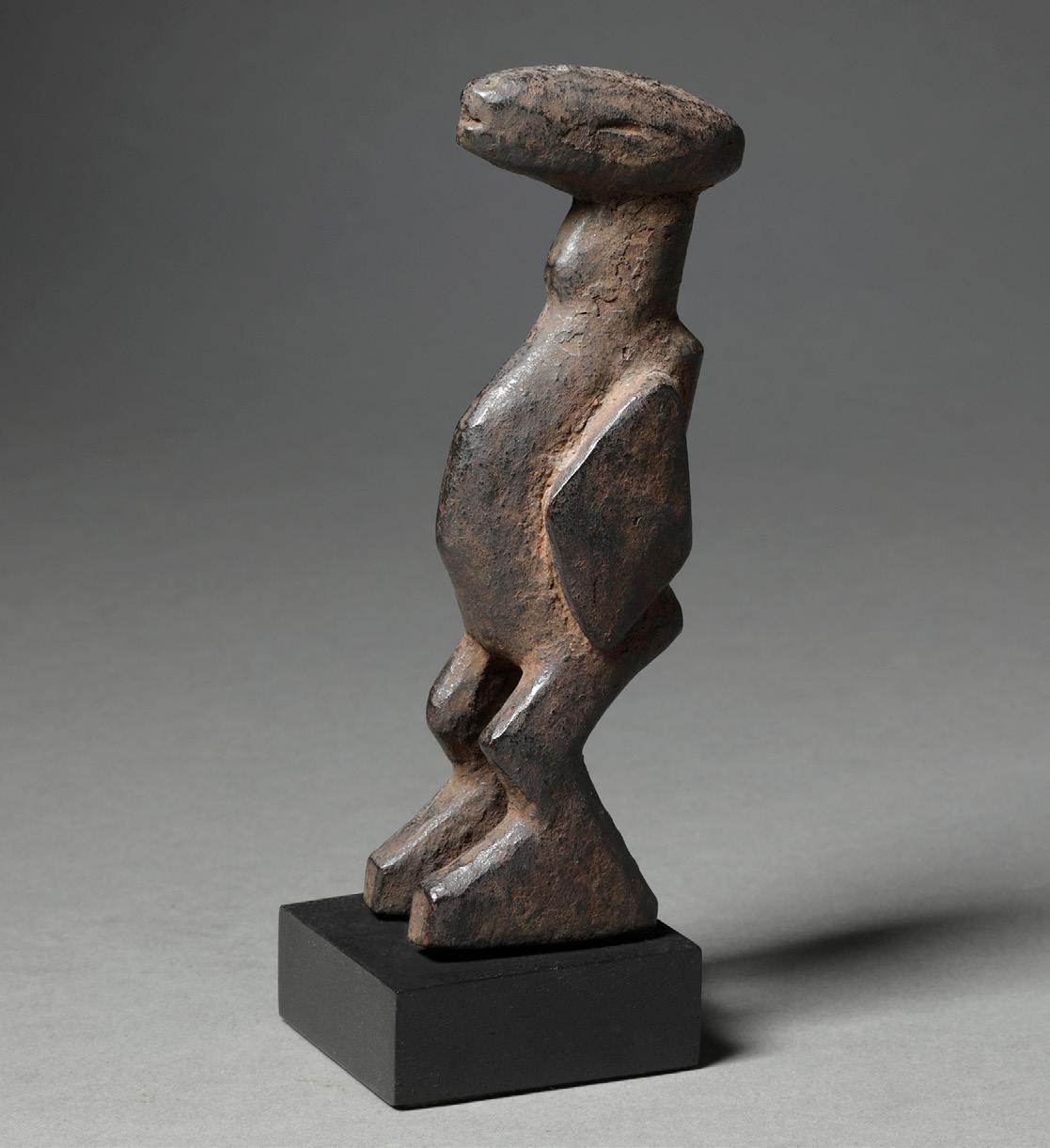


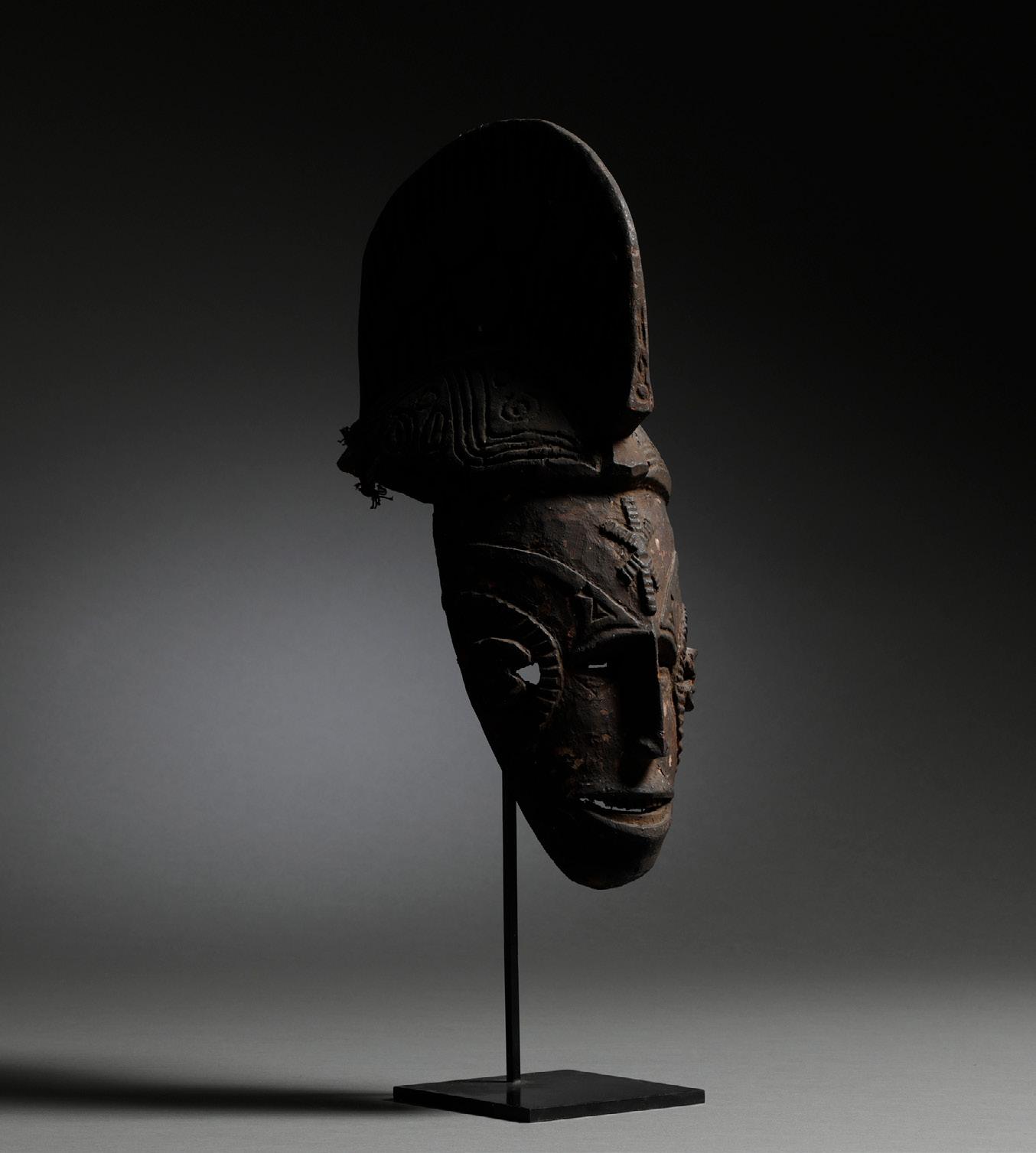
HELMET MASK AGBOGHO MMUO
IBO (IGBO), NIGERIA
Late 19th century
Wood, pigments
Height: 14 in, 35 ½ cm
PROVENANCE
Ernst (1914-2002) & Ruth Anspach, New York, USA. Ernst Anspach was one of the most renowned American collectors of African art. Born in Germany, he came to America in 1936 and acquired his first African piece in 1956, buying initially his first 60 pieces from J. J. Klejman and Julius Carlbach. Roy and Sophie Sieber Collection
EXHIBITION HISTORY
New York, USA: ‘African Tribal Sculpture from the collection of Ernst and Ruth Anspach,’ The Museum of Primitive Art, 15 November 1967–4 February 1968
PUBLICATION HISTORY
Expo cat.: ‘African Tribal Sculpture from the Collection of Ernst and Ruth Anspach,’ New York, The Museum of Primitive Art, 1967:5
While masks depicting young females are most common in agbogho mmuo performances, Chinyere G. Okafor argues that the tradition is not limited to youthful spirits; instead, it refers more broadly to masks representing the female ‘essence.’
Classic agbogho mmuo masks portray an idealized image of a young woman in Igbo society. These ideals emphasize tight proportions, a slender nose, and a small face relative to a much larger coiffure. Its spiritual nature is indicated by a white complexion. This is achieved with the application of kaolin, a chalk-like pigment used for ritual decoration of the body in both West Africa and the African Diaspora. Kaolin is also used in uli – abstract, linear designs created by Igbo women to beautify bodies and community structures.
Agbogho Mmuo, or Maiden Spirits, are annual performances held during the dry season in the Nri-Awka area of Nigeria, the northern part of traditional Igbo territory. Performed only by men, these masquerades imitate the character of adolescent girls, exaggerating the girls’ beauty and movements. Their dances are accompanied by musicians who sing and play tribute to the graces of women both real and spiritual.
Most maiden spirit masks are decorated with representations of hair combs and other objects modeled after late nineteenth-century ceremonial hairstyles. These hairstyles include elaborate modelings and crests intended entirely to add aesthetic grandeur to the mask.
The present example is confidently carved, compellingly detailed, and channels its compositional focus toward the face with its subtly nuanced expression. Surface designs over the entirety of the mask are both embossed and incised, deploying a mixture of flowing, organic lines and tighter geometric devices to masterful effect. Anspach and other collection numbers on back of mask.





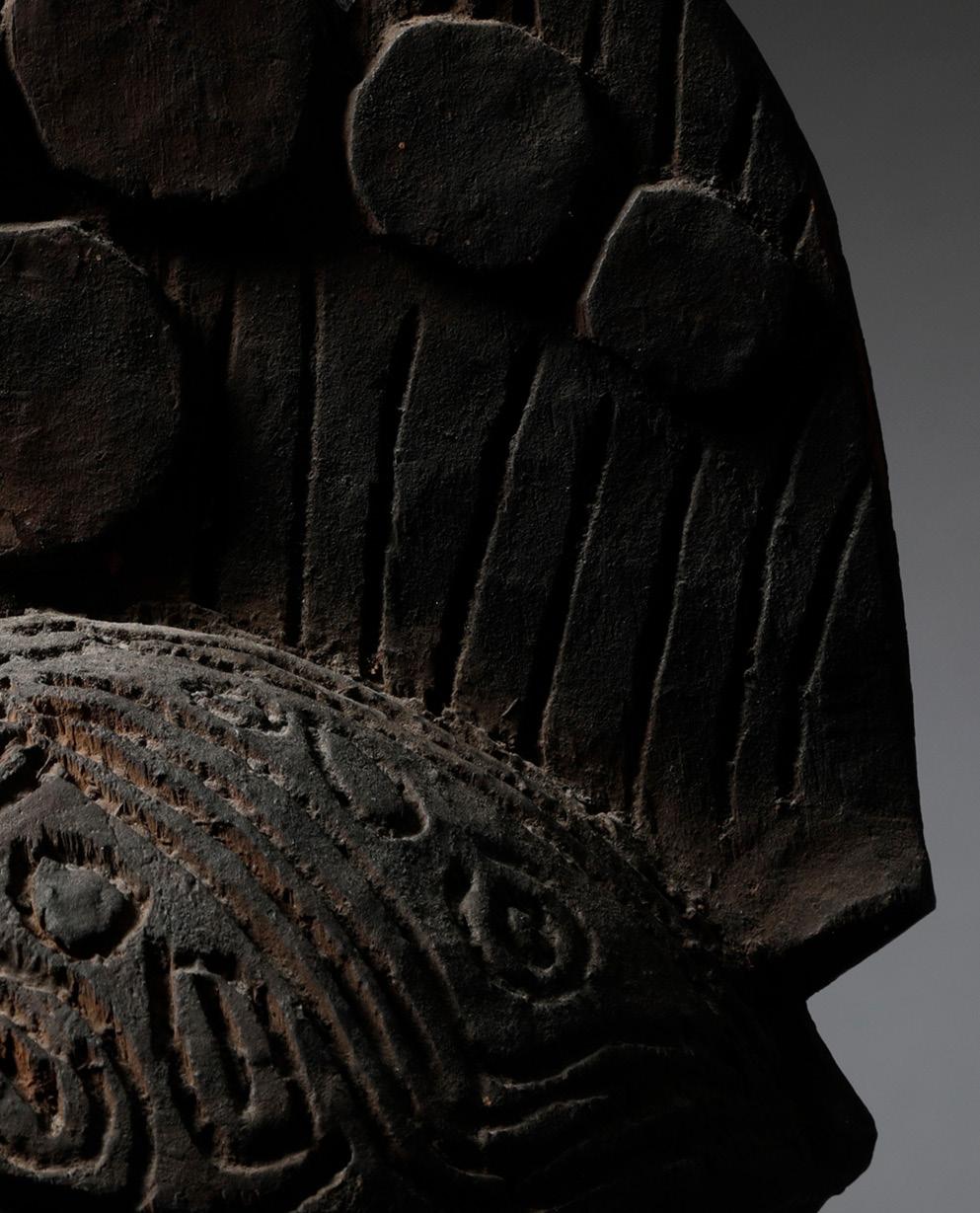

MASK
IBIBIO, NIGERIA
Late 19th/early 20th century
Wood, paint
Height: 12 in, 30 cm
PROVENANCE
Roy and Sophie Sieber Collection
PUBLICATION HISTORY
Robbins (Warren M.) & Nooter (Nancy Ingram), ‘African Art in American Collections, Survey 1989,’ Washington/London: Smithsonian Institution Press, 1989:270, #707
Among the Ibibio in Nigeria, the Ekpo society acted as an agent of social control, propitiating the ancestors for the welfare of the group, upholding the authority of the elders, and generally maintaining order in the absence of a centralized state. The security structures of daily life were assured by the appearance of the ancestors through wooden face masks. These portrayed the consequences of one’s actions in life and the effect they had upon a person’s spiritual destiny.
Disfiguring diseases were regarded as divine retribution for misdeeds, a justified punishment inflicted for transgressions of the social contract. A mask depicting a face ravaged by leprosy, gangosa, or smallpox showed the reward one could expect from evildoing, striking fear into the public and instilling respect for the rules of the Ekpo society.
Once a year, Ekpo masks emerged from their secluded
forest lodges and appeared in the village for a period of about three weeks. Maskers performed largely for initiated men, but on the first and last days of the harvest season a performance open to the entire population took place at the most important marketplace. Once gathered, the ekpo dancers swirled around the arena with incredible vigor and unpredictability, lunging and leaping in chaotic bursts, threatening the crowd and one another. The Ibibio recognized that once a mbop (mask) was put on, an ancestor’s soul (ekpo) possessed the wearer, allowing the masquerader to commit acts of havoc with impunity.
This remarkable mask is elaborately structured, showing a skull-like face and additional maskettes to either side. The macabre grin and wide, staring eyes of this mask must have enthralled the crowds before whom it danced, leaving a lasting impression of a stricken soul.





HEADREST ISIGQIKI
KWAZULU-NATAL, SOUTH AFRICA
Late 19th/early 20th century
Wood
Height: 6 in, 15 cm; Length: 12 in, 30 cm
PROVENANCE
Roy and Sophie Sieber Collection
Zulu headrests are distinctive for their heavy designs that often feature rectilinear shapes and blocky legs in a benchlike configuration. Their legs are sometimes deployed in more than one pair, which lends a zoomorphic impression. This allusion is in some cases clear, referencing the precious cattle of Zulu herders, and at others more oblique.
The upper plane of this example is gently bowed, its concave curvature playing against the convex contours of the thick, strong, rounded legs that exude a certain vitality. Also in dialogue with the theme of curvature are the decorative incised panels which cover the frontal faces of the legs. Their tight, geometric delineation activates a direct and contrasting aesthetic tension with the rest’s swelling and flexing forms that speaks to the sophistication of the carver.



TORQUE OR CURRENCY OBJECT
YORUBA, NIGERIA
17th –19th century
Copper alloy
Height: 10 in, 25 cm
PROVENANCE
Roy and Sophie Sieber Collection
Copper was a rare and highly prized commodity in Africa, attained either through trade with Europe or from select areas on the continent, such as Morocco to the north and Katanga in the Congo. When European ships began arriving along the west coast of Africa during the sixteenth century and later, they carried brass manillas, braceletshaped weights in different sizes that served as a medium of exchange. The Yoruba melted these down, separating the copper and zinc, and recast the copper into similar but much larger objects called torques. The Ogboni society of the Yoruba also created important ritual objects from the metal extracted from manillas.
Owning torques reflected considerable wealth, and flaunting them was a conspicuous display of social prestige. Though some were worn as necklaces by women, others were used according to their size, from small currency objects to large ceremonial pieces.
Considering its size, this stunning torque was possibly given as a wedding dowry, and the standing of the owning family was reflected in the weight and symmetry of the piece. An elegant power resonates in its heavy, flexed arc, the girth of which terminates in mirrored, delicate points that emerge from flat disks, barely touching at their tips, expressing great balance, control, and restraint.



ARMLET/BRACELET ERRAP
MAASAI, KENYA
Late 19th century
Wood, horn, glass beads, metal
Height: 18 in, 46 cm
PROVENANCE
Roy and Sophie Sieber Collection
This type of arm ornament, known as errap, was worn on the upper arm and was reserved for use by warriors who had taken life in battle. Carved of cow horn and tipped with tassels of fine chain, its form recalls the head and horns of an animal. The blend of curve, angle and line at play in this piece imbues it with a lively sense of poise. This errap is the finest example we have handled.
Errap were created by mothers for their sons, and
were traditionally worn on ceremonial occasions such as weddings. These special ornaments are becoming rare as young Maasai men have gradually left the ancestral schools and embraced modern modes of education. Despite their decline, errap have a lasting importance in Maasai communities and are treasured by the families who own them. With fine, old native repair.



MINIATURE MASK
DAN, IVORY COAST
Early 20th century
Wood
Height: 3 ½ in, 9 cm
PROVENANCE
Roy and Sophie Sieber Collection
Masks of the culturally related groups of Côte d’Ivoire and Liberia, including the Dan, are sometimes carved in miniature. Ranging in height between six and twenty centimeters, even the largest of them are too small to be worn over the face, and they rarely disclose any means of attachment. The most common mask type represented in such diminutive form is dean gle (attractive mask with slit eyes, performs a feminine behavior) while the least common are masks with tubular eyes and animal mouths. These maskettes are variously called ma go (small head), yi luo po (thing which water is poured over), gba po (thing which is fed), or nyonkula (substitute for the ancestors). Each type of mask fulfills a particular function. Anyone with a spiritual connection to a mask, or whose family owns an important one, is entitled to commission a small copy. They are wrapped up and kept on the owner’s body or among their possessions and function as portable and personal forms that share the power and protective force of the full-sized mask. When a mask-owner is traveling, the miniature mask serves as an important means of identification outside their
immediate community. This role may have given it the commonly applied name of ‘passport mask.’
Miniature masks may also play a communal role in secret societies. They are among the sacred objects displayed at men’s society meetings, and on these occasions they serve a protective role, representing the benevolent spirits associated with the area’s primary masquerades.
Whether personal or collective, miniature masks must be fed regularly to remain strong and able to help their owner. Food may be simply set before it, or the offering, such as rice or oil, may be rubbed or poured onto it. On special occasions a sacrificed chicken’s blood is spilled onto the mask. This range of offerings explains the variety observed in the patinas of these miniatures.
The black surface of this example has been richly textured by many feedings, leaving it lustrous and encrusted. Its concave face, slit eyes, and domed forehead suggest it is a feminine dean gle, though the incised circles circumscribing the eyes are a less common feature of these masks.



PRESTIGE AXE MANZHI
KIRDI, CAMEROON
Late 19th/early 20th century
Brass
Height: 18 in, 46 cm
PROVENANCE
Roy and Sophie Sieber Collection
African metalworkers have historically been noted for their fabulous ceremonial weaponry. This vast kingdom of objects, both artistically and technically impressive, boasts a dazzling variety of designs that often forgo function in the pursuit of extravagant form.
This handsome Kirdi axe, called manzhi, is an ideal example. It is crafted entirely of brass and was composed, poured and forged using a waste mould process. The flaring, block-shaped blade sports a long, curving tail that represents a rooster – a distinctive design that was likely introduced to the Kirdi by the Fali, for whom the rooster is a sacred animal. Detailed relief work resembling dense
braids adorn the bottom edge of the blade and wrap the neck and base of the haft. Several tight spiral motifs are found at the blade’s lower edge. The wide, blank face of the blade shows a lovely visual texture that suggests the subtle rippling of still water or a smooth sand dune.
Like all prestige weapons, the manzhi was a conspicuous status object that signaled its owner’s social rank. Among non-Islamicized tribes in the Adamaua Mountains of northern Cameroon, these brilliant axes appeared at dances and were carried during funerary rites by the closest male relative of the deceased.

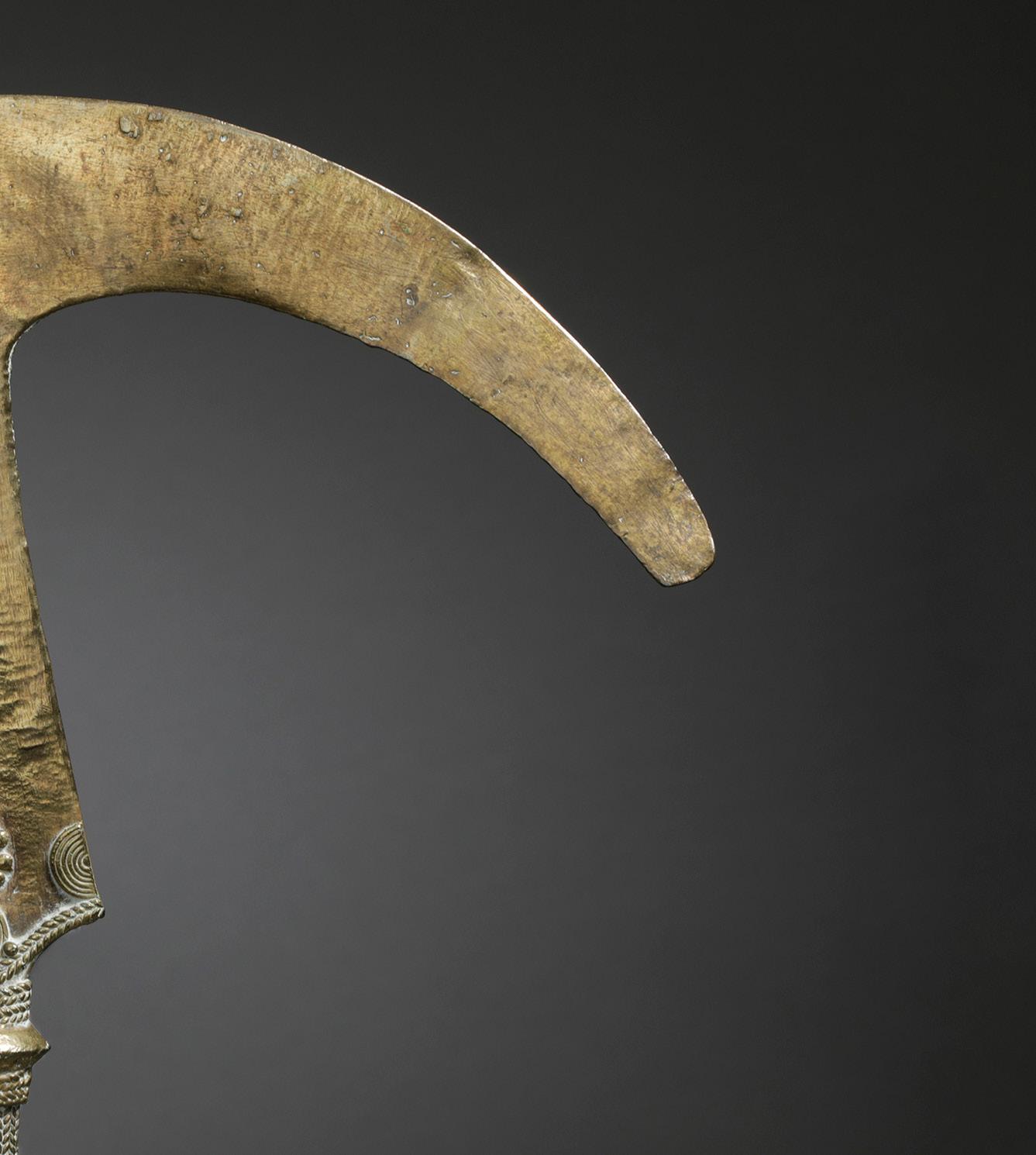

36
STANDING FIGURE
LEGA, DRC
Late 19th/early 20th century
Bone
Height: 3 in, 7 ½ cm
PROVENANCE
Roy and Sophie Sieber Collection
The predominance of the esoteric Bwami men’s society has historically influenced much of the art production in Lega culture. Bwami beliefs are pervasive in all aspects of life, shaping individual growth and governing social and legal norms. Masks, heads, and figurines made of wood and ivory are involved in initiatory rites for the society’s highest grades. Their multilayered symbolism is propagated through sayings, theatrical performances, and dances. This stylized figure, known as kalimbangona, was used in Bwami initiation rites. Kalimbangona figures were powerful
instructional vehicles, regarded as physical embodiments of Bwami teachings. They were highly prized objects and were seen as indicators of high social status in Lega communities. A dreamlike and surrealist aura marks this example, with its mask-like head attached directly to a descending fork resembling abstract legs. The large, hollow eyes and minimal features of the face deliver a highly enigmatic impression, and the whole work is enriched by a heavily mottled and textured surface. Two old collection numbers on the underside of the base.



HEADREST
BARI, SOUTH SUDAN
Late 19th/early 20th century
Wood, leather
Height: 5 in, 13 cm; Width 9 in, 23 cm
PROVENANCE
Roy and Sophie Sieber Collection
Personal headrests are a widespread tradition across the African continent. They support the head during sleep, cradling it along the jawline, elevating it from the ground and aligning the spine. At the same time, headrests prevent fragile and time-intensive coiffures – important emblems of social status, age, and gender – from being dirtied or damaged. While some cultures in sub-Saharan Africa associate headrests with dreaming and spiritual communication, in eastern Africa they are strictly utilitarian items.
The oldest preserved headrests in Africa were found in Egypt and have been dated to the second and third dynasties of the Old Kingdom (ca. 2649–2150 bc ). Influences of some of the ancient Egyptian headrest forms, such as the solid block design, can be seen in east African
examples created thousands of years later. Similarities in comparatively recent designs are shared between groups in the neighboring countries of Ethiopia, Kenya, South Sudan, and Uganda. Headrests were once used widely among the pastoralist groups of this region, but the tradition has largely disappeared with the decline of pastoralist lifestyles.
This smooth, lustrous Bari rest from South Sudan forgoes surface detail in favor of pure form. Carved from a single, unembellished piece of wood, it has two flexed legs that curve down from either end of a rectangular central platform. Twisted leather thongs bind the legs and connect to the underside of the rest in four columns, holding the structure firm and allowing convenient points for grasping or attachment.

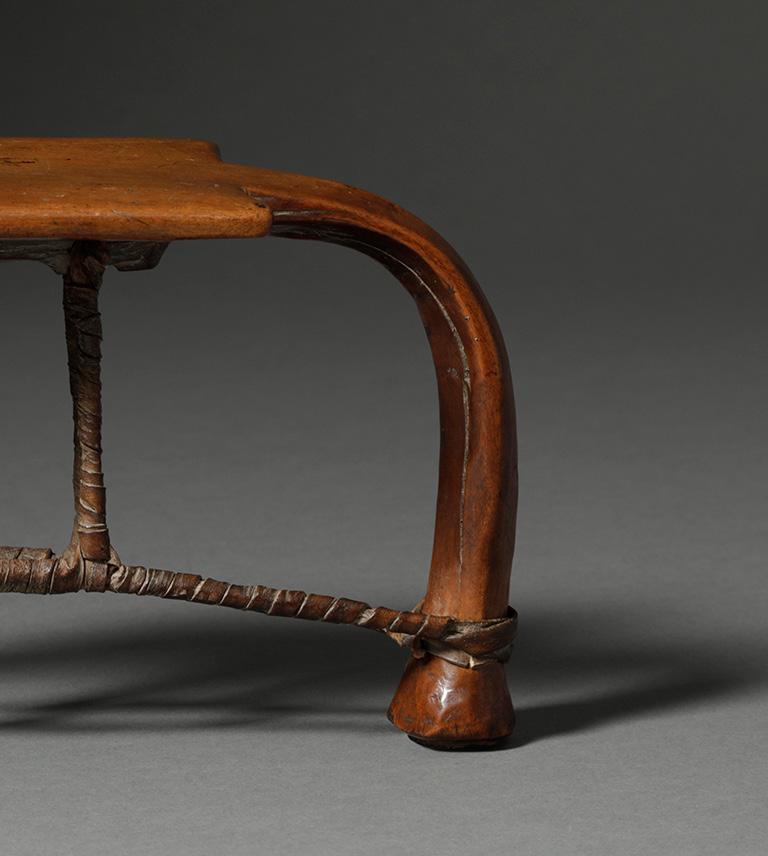

TWO WIREWORK SNUFF GOURDS
ZULU, SOUTH AFRICA
Late 19th/early 20th century
Gourd, copper and brass wire
Height: 3 ½ in, 9 cm (for the taller gourd)
PROVENANCE
William Downing Webster (1863–1913). Originally a draftsman and stained-glass window designer who traveled widely around Europe. In the 1890’s he became an ethnographic collector and dealer, buying from private individuals including other collectors and members of the armed forces who had served abroad. He was based in Bicester and London.
Roy and Sophie Sieber Collection
These two spherical containers are made from small gourds and are expertly decorated with inlaid strips of wire. A wide band of copper strands, and one of brass, are used to create concentric circles and chevron-like shapes. The metallic shine and faceted, raised surface of the wire contrasts with the smooth, dark, and glossy surface of the gourd body and must have given much pleasure when touched and handled.
Some gourds were left plain, others engraved, hatched, or decorated using a pyrogravure technique that saw patterns burnt into the surface. Still others were embellished with beadwork and, like in this example, neat strands of copper and brass wire inlay, creating geometric or botanical motifs. This decoration was achieved by first cutting the wire to the desired lengths. Each end was then inserted into small holes that had been pre-bored into the gourd shell with an iron
point. The ends were left unfinished inside the gourd as the opening is too small to be able to fasten them in any other way.
This particular form of snuff container, with and without its wire embellishments, is found throughout the KwaZulu-Natal region with museum curator Margaret Shaw placing many at the Natal-Pondoland border and others in Zululand. There are a few photographs of these gourds in the Van Warmelo archive at the University of Johannesburg which he provenanced to Natal in the area below the Thukela River (which was the British Colony of Natal from 1843 to 1910). A similar calabash snuff container found in the Zambezi River region by Müller and Snelleman is decorated with engraved and hatched triangles and squares and suggests a wide-spread use for this type of container.



GOURD
TURKANA/MERU, KENYA
20th century
Gourd, metal
Height: 26 in, 66 cm
PROVENANCE
Roy and Sophie Sieber Collection
Gourds are used throughout Africa for a wide range of practical, cultural, and artistic purposes. Common uses include being used as containers and utensils, musical instruments, decorative arts, religious and ceremonial uses, medicinal uses and for cooking and fermentation. This large and beautiful gourd was treasured enough to have been repaired with metal. For a similar example, see African Forms by Marc Ginzberg, p. 79.

PRESTIGE AXE
MBALA OR PINDI, DRC
Late 19th/early 20th century
Wood, metal
Height: 13 in, 33 cm
PROVENANCE
Roy and Sophie Sieber Collection
Like many cultures across central Africa, the Mbala and Pende used their skill in metalworking to craft extravagant ceremonial weapons. These remarkable objects can push the sculptural form of a weapon to the limit, attaining a kind of artistic metamorphosis. As symbols of status, they were owned by individuals of ample means and social standing who carried them at community events. The materials with which they were constructed – metals like copper and bronze, as well as ivory and fur – also communicated wealth.
This handsome axe features a dramatically curved, parabola-shaped blade projecting out from the top of the haft by a slender horizontal bar, a design widely used for this type of prestige piece. The finial placed opposite the blade is fully decorated with brass tacks and plating, and juts out with an anthropomorphic quality, suggesting a head and neck. Tightly wrapped wire covers the entire grip. The axe is dominated by brass tones, pulling together its sculptural elements in a strong aesthetic unity.



MALE STANDING FIGURE OKEGA OR IKENGA
IGALA OR IGBO, NIGERIA
Late 19th century
Wood, pigments
Height: 27 in, 68 cm
PROVENANCE
Gerard Schraverus, The Netherlands
Ursala Voorhuis (1932–2021), The Netherlands, 1976. Voorhuis did field research in Nigeria and started collecting in the 1960s.
Sotheby’s, New York, November 1999. Lot 118.
Roy and Sophie Sieber Collection
Carved out of wood and anywhere from a few inches to about two feet tall, an ikenga figure symbolizes its owner’s right hand: the hand of action and accomplishment, of confronting and overcoming life’s challenges. It is, in essence, a sacred symbol of personhood. An Igbo man may ritually be offered a male ikenga when he comes of age, and it becomes not only his possession to be proudly preserved and honored in perpetuity, but also an integral part of his very identity. The figure embodies his chi (personal god), his ndichie (ancestors), and ike (power). When its owner dies, the ikenga often dies along with him, being split apart and discarded. The profound personal importance and unimpeachable sanctity of the ikenga within Igbo belief is
well illustrated in Chinua Achebe’s novel Arrow of God, in which one character, Akukalia, breaks the ikenga of a man named Ebo, and Ebo shoots Akukalia to death without any consequences from the village elders or the community.
Male ikenga usually depict one or more standing, horned figures, often holding a sword or other blade in their right hand. This ikenga follows a classic model with fully formed features, large vertical horns, and an upraised blade along with additional implements. The figure stands upon a shallow base or dais which bears relief designs. Massed proportions in the chest, shoulders, head and crowning horns lend the figure a palpable sense of strength and toughness, emphasized by a heavily textured patina.
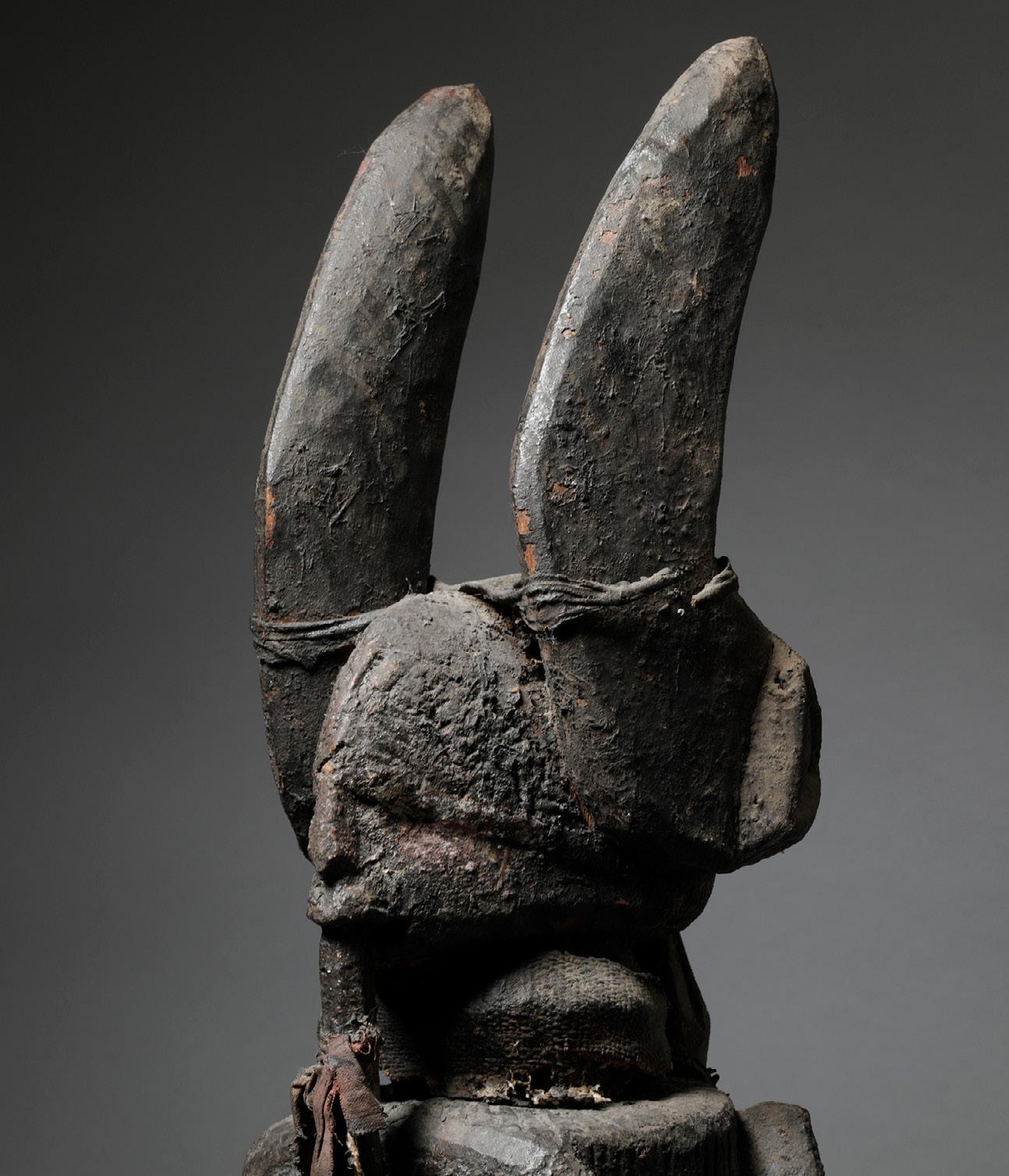







CHILD FIGURE NGUANA MODULA
SOUTH SOTHO, LESOTHO/SOUTH AFRICA
Late 19th/early 20th century
Wood, glass beads, sinew, hide, brass button
Height: 8 ½ in, 22 cm
PROVENANCE
Roy and Sophie Sieber collection
Composed of a near conical wooden core sheathed in beadwork, this object is not a doll in the conventional Western sense, but rather a woman’s fertility figure in the form of an adult female. Such figures, which incorporate talismanic material, were once used by the bride during marriage ceremonies to ensure fertility and were also employed by childless women to overcome barrenness. There are several types of Sotho figures; the present piece is of the wood-core variety. This type of figure has been in use since at least the late nineteenth century.
The checkered beadwork pattern and blue, white, and rose color combination is distinctively Sotho. The wood core would have been carved by a man and then ‘dressed’ by a woman in its finely worked bead wrapping. Details to the head – in this case, an abstract coiffure and face – enrich the doll’s anthropomorphic character as do the finely beaded arms hanging on the side of the figure.
Old collection # 53 on underside.



HEADREST XIKHIGELO
TSONGA, ZIMBABWE/MOZAMBIQUE/SOUTH AFRICA
Late 19th/early 20th century
Wood
Height: 5 in, 13 cm
PROVENANCE
Roy and Sophie Sieber Collection
Ubiquitous in southern African societies, headrests were prized and revered as indispensable items, not only for their protection of carefully maintained coiffures during sleep but also in their spiritual role as conduits of communication with ancestor spirits.
This gem of a headrest shows the primary hallmarks of the Tsonga carving tradition, with a gently convex platform flanked by downward-pointing flanges, an openwork center, and a stout, figure-eight base. Surface details are limited to the foot of the rest, which is grooved with a host of shallow, overlapping channels that evoke a profusion of roots. The central design with its hourglass-shaped framework is eyecatching, and the slenderness of its elements is emphasized by the thick, trunk-like base. Old collection number 1214 on underside.

